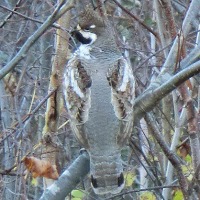 |
Hazel Grouse (Tetrastes bonasia)
EZORAICHOU
Habitat: Woodlands from lowlands to mountainous areas in Hokkaido year round. Forages for insects, sprouts and young leaves on the ground.
Voice: Metalic she she she, or pii cho pii cho.
♪ female: H Kuroda
♪ female: H Kuroda
|
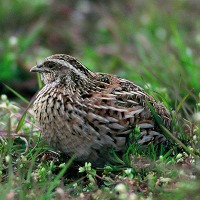 |
Japanese Quail (Coturnix japonica)
UZURA
Habitat: Grasslands, agricultural lands and dry riverbeds from lowlands to mountainous areas throughout Japan, but the population is small. Resident.
Voice: Calls distinctive guku krrrr (kukroo or ajapah ) repetitively in the dark before dawn in April and May.
♪ call: T Nanba
♪ call: T Hirano
|
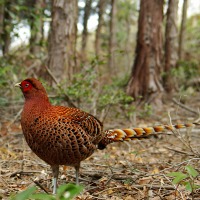 |
Copper Pheasant (Syrmaticus soemmerringii)
YAMADORI
♪ call: K Kajimoto
See more |
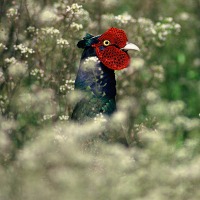 |
Pheasant / Common Pheasant (Phasianus colchicus)
KIJI
Habitat: Grasslands, bushes, open woods, dry riverbeds and agricultural lands from lowlands to mountainous areas in Honshu and to the south. Commonly occurs open fields in residential areas.
Voice: Loud ko kyok (ken kehn) is followed by dobodobo sound of wingbeats. When foraging with chicks, it calls kokokoko like a hen.
♪ call: T Hirano ♪ call: H Kuroda
♪ call: T Hirano ♪ female: T Hirano
|
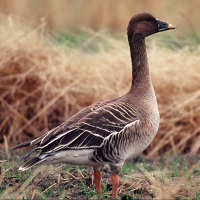 |
Taiga Bean Goose (Anser fabalis)
HISHIKUI
♪ call: T Nanba
|
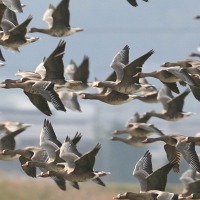 |
Greater White-fronted Goose (Anser albifrons)
MAGAN
♪ call: T Nanba
♪ flock: T Nanba
|
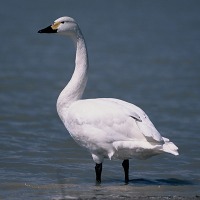 |
Tundra Swan (Cygnus columbianus)
KOHAKUCHOU
Habitat: Inner bays, lakes and ponds, rivers and agricultural lands in Hokkaido and Honshu. Winter visitor. Can be distinguished from similar-lookingWhooper Swan by its smaller size and shorter neck. The shape of the yellow part on its bill is round.
Voice: Calls koho koho but difficult to distinguish from Whooper Swan by voice.
♪ call: K Kajimoto
♪ call: H Kuroda
|
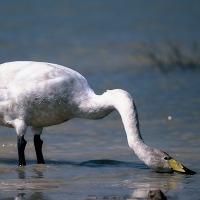 |
Whooper Swan (Cygnus cygnus)
OOHAKUCHOU
Habitat: Inner bays, lakes and marshes, rivers and agricultural lands in Honshu and Hokkaido.Winter visitor. Distinguished from Tundra Swan by the bigger body and the longer neck. The black part of the bill is narrower than that of Tundra Swan.
Voice: Call is koh koh. Difficult to distinguish from Tundra Swan by its voice.
♪ call: T Hirano
|
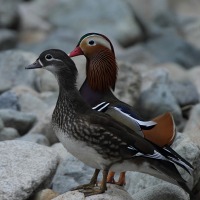 |
Mandarin Duck (Aix galericulata)
OSHIDORI
♪ call: T Hirano
♪ flight call: T Hirano
|
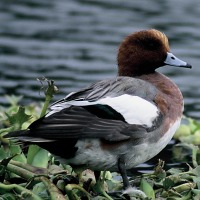 |
Eurasian Wigeon (Anas penelope)
HIDORIGAMO
♪ call: K Kajimoto
♪ call: K Kajimoto
|
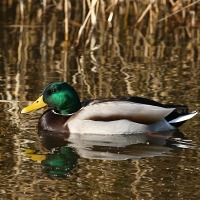 |
Mallard (Anas platyrhynchos)
MAGAMO
♪ call: K Kajimoto
♪ courtship: H Kuroda
|
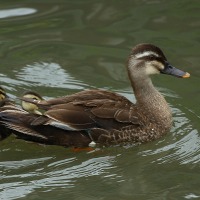 |
Eastern Spot-billed Duck (Anas zonorhyncha)
KARUGAMO
♪ call: K Kajimoto
♪ juvenile: K Kajimoto
See more |
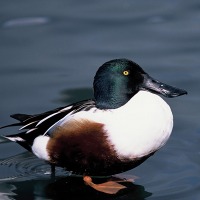 |
Northern Shoveler (Anas clypeata)
HASHIBIROGAMO
♪ call: T Hirano
|
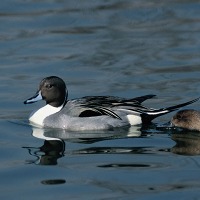 |
Northern Pintail (Anas acuta)
ONAGAGAMO
♪ call: K Kajimoto
♪ call: K Kajimoto
|
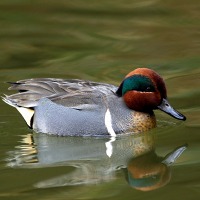 |
Eurasian Teal (Anas crecca)
KOGAMO
♪ call: M Ueta
♪ call: K Kajimoto
|
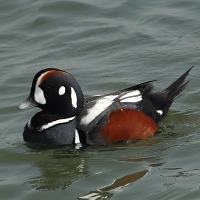 |
Harlequin Duck (Histrionicus histrionicus)
SHINORIGAMO
♪ call: M Ueta
|
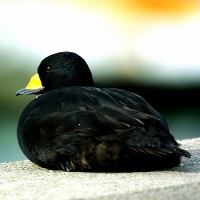 |
Black Scoter (Melanitta americana)
KUROGAMO
♪ call: T Moriya |
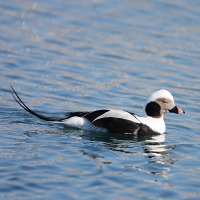 |
Long-tailed Duck (Clangula hyemalis)
KOORIGAMO
♪ call: T Nanba
|
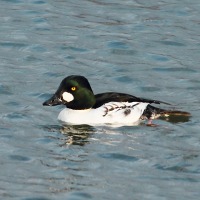 |
Common Goldeneye (Bucephala clangula)
HOOJIROGAMO
♪ call: T Nanba
|
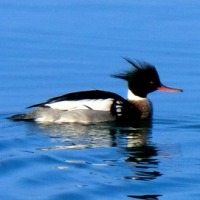 |
Red-breasted Merganser (Mergus serrator)
UMIAISA
♪ courtship: H Kuroda
|
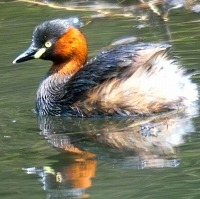 |
Little Grebe (Tachybaptus ruficollis)
KAITSUBURI
Habitat: Lakes, rivers, reservoirs, ports and harbors throughout Japan. Some move from northern Japan to warmer regions in winter. Common resident.
Voice: Song is kyu ru ru ru roo in a high-pitched tone. Sometimes calls pit or kit, pausing after each sound.
♪ call: K Kajimoto ♪ call: T Hirano
♪ call: K Kajimoto ♪ juvenile: T Hirano
|
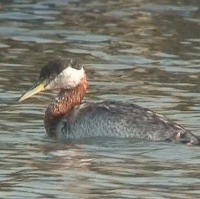 |
Red-necked Grebe (Podiceps grisegena)
AKAERIKAITSUBURI
Habitat: Lakes and marshes and inner bays from lowlands to mountainous areas. Winter visitor in the south of Honshu. Rare in small ponds or marshes. Larger than Little Grebe.
Voice: Heck kere kere kere during breeding season and on breeding sites.
♪ call: T Nanba
|
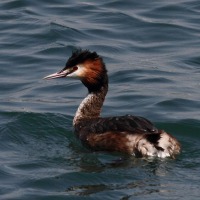 |
Great Crested Grebe (Podiceps cristatus)
KAMMURIKAITSUBURI
♪ call: H Kuroda
♪ courtship: K Mikami
♪ juvenile: K Mikami
|
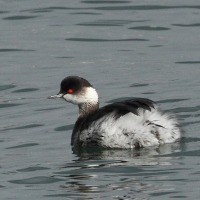 |
Black-necked Grebe (Podiceps nigricollis)
HAJIROKAITSUBURI
♪ call: H Kuroda
|
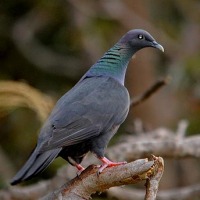 |
Japanese Wood Pigeon (Columba janthina)
KARASUBATO
Habitat: Dense broadleaf forests, mainly on islands in central Honshu and to the south all year round. Common on Izu-shoto islands. Eats nuts and fruits etc.
Voice: Low eerie voice that sounds like woo ah.
♪ song: M Ueta
|
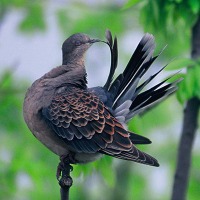 |
Oriental Turtle Dove (Streptopelia orientalis)
KIJIBATO
Habitat: Forests, agricultural lands, dry riverbeds and urban areas from lowlands to mountainous areas throughout Japan. Common resident. Those in Hokkaido migrate to warmer regions in winter.
Voice: Crooning voice repeatedly der der pou pou der der pou pou and calls in muffled voice kuu, uu or pwuu (goa goa goa).
See more
♪ song: M Ueta ♪ threat: M Ueta
|
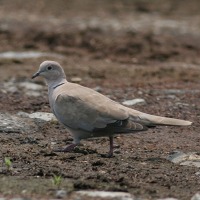 |
Eurasian Collared Dove (Streptopelia decaocto)
SHIRAKOBATO
Habitat: Mostly in Saitama Prefecture and a part of Gunma, Tochigi and Chiba Prefectures as well as Tokyo. Mainly lives in agricultural lands, residential areas and on dry riverbeds, easily found in the vicinity of stables, particularly of pigs’. Resident.
Voice: Call is popoppou, popoppou. Weaker than Oriental Turtle-dove.
♪ song: T Moriya
|
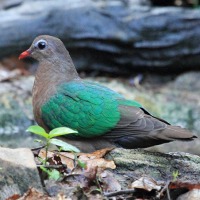 |
Common Emerald Dove (Chalcophaps indica)
KIMBATO
♪ call: M Takagi
|
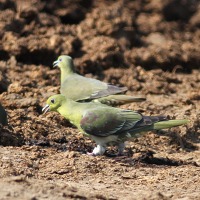 |
White-bellied Green-pigeon / Japanese Green Pigeon
(Treron sieboldii)
AOBATO
Habitat: Woodlands, from lowlands to mountainous areas throughout Japan year round, and visits on shore reefs to drink saltwater. Northern population migrates to warmer regions in winter.
Voice: Low and cadent voice, Ahoh ah oh.
See more
♪ call: K Kajimoto
|
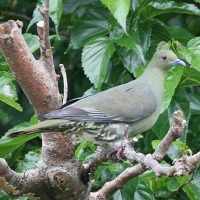 |
Whistling Green Pigeon (Treron formosae)
ZUAKAAOBATO
Habitat: Woods and residential areas from lowlands to mountainous areas in Nansei-shoto islands from Yakushima island and to the south. Resident. Feather color similar to Japanese Green Pigeon and body size a little larger.
Voice: Repetitive poaa pooaaoo like the tone of Shakuhachi, a five-holed Japanese bamboo clarinet.
♪ call: M Takagi
|
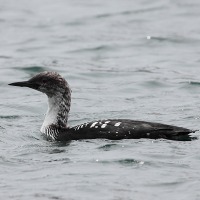 |
Pacific Loon (Gavia pacifica)
SHIROERIOOHAMU
♪ call: T Nanba
|
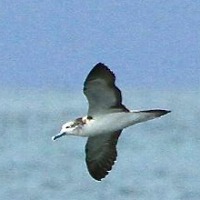 |
Streaked Shearwater (Calonectris leucomelas)
OOMIZUNAGIDORI
♪ duet: M Ueta
|
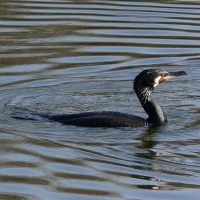 |
Cormorant / Great Cormorant (Phalacrocorax carbo)
KAWAU
Habitat: Watersides of lakes, rivers and harbors throughout Japan. Moves in a flock of several- hundred birds, and dives to catch fish deep under the water.
Voice: Call is gock gock or guwaa.
♪ call: K Kajimoto
♪ call: T Hirano
♪ alarm: H Kuroda
|
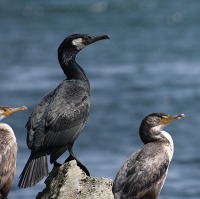 |
Japanese Cormorant (Phalacrocorax capillatus)
UMIU
♪ colony: R Kurosawa
See more |
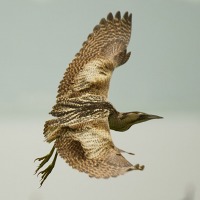 |
Eurasian Bittern (Botaurus stellaris)
SANKANOGOI
Habitat: Watersides in vast reed beds throughout Japan but population is small.
Voice: Mostly stays inside of reed beds and gives low and loud voice from evening to early morning from around March. Call is bwooo bwooo in 4 or 5 notes and the last note often lower. Can be heard clackety clack (kachi kachi) sound made by hitting bills before the call from short distance. Similar to American Bull Frog, but can be distinguished by more inflecting and even lower voice than the frog.
♪ call: T Hirano
|
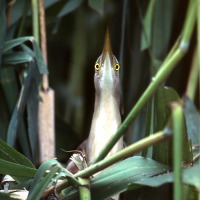 |
Yellow Bittern (Ixobrychus sinensis)
YOSHIGOI
Habitat: Rivers and lakes with rich reed beds in lowlands throughout Japan. Summer visitor. Makes flutteringly flapping flight over reed beds around June and July.
Voice: Loud voice whoa whoa or wooo wooo in each note separately in daytime and at night. Fledglings gives kya kya kya kya call in reed beds.
See more
♪ call: T Hirano
♪ fledgling: T Hirano
|
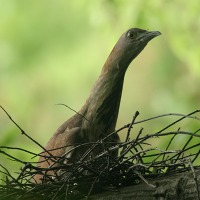 |
Japanese Night Heron (Gorsachius goisagi)
MIZOGOI
Habitat: Woods with streams from hills to low-mountain areas in Honshu and to the south. Summer visitor, but the population is small.
Voice: Calls bwoo bwoo bwoo (poh poh) with each note separately during dark time hours in the evening and morning. Difficult to observe the bird, but sometimes comes out on forest roads.
See more
♪ call: K Kajimoto
|
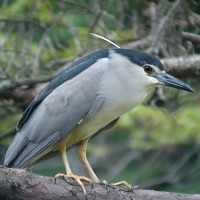 |
Black-crowned Night Heron (Nycticorax nycticorax)
GOISAGI
Habitat: Mainly alongside of lakes, rivers and paddy fields in Honshu and southwards.Resident, but some living in the northern areas move to warmer regions in winter. Usually active in the evening, and the calls heard even in residential areas at night.
Voice: Call is loud and short goa, kwa, etc.
♪ call: T Hirano
|
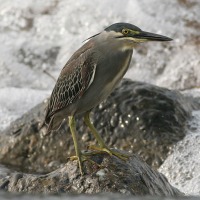 |
Striated Heron (Butorides striata)
SASAGOI
Habitat: Lakes, ponds and rivers from lowlands to mountainous areas in Honshu and to the south. Summer visitor. Occurs in parks in urban areas as well. Usually doesn’t make a flock and is often solitary.
Voice: Sharp kyeowp, qewee, pyuu or tiuu (pyoo or kyoo). Similar to the voice of Japanese Green Woodpecker which gives peoo peoo or piyoo piyoo piyoo in parks, but Striated Heron rarely gives continuous call.
♪ call: T Hirano ♪ call: T Hirano
♪ fledgling: T Hirano
♪ nestling: T Hirano
|
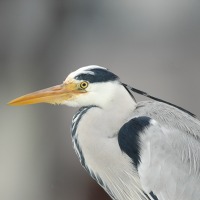 |
Grey Heron (Ardea cinerea)
AOSAGI
Habitat: Widespread on lakes, rivers, agricultural lands and sea coasts throughout Japan in large numbers. Breed colonially on trees.
Voice: Calls loudly even at dusk and dawn. Identifiable by more drawling call than Black-crowned Night Heron.
♪ call: K Kajimoto
♪ colony: K Matsunaga
|
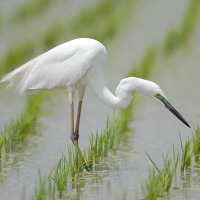 |
Great Egret (Ardea alba)
DAISAGI
♪ call: H Kuroda
|
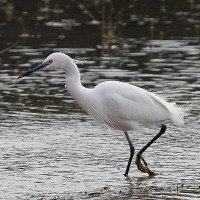 |
Little Egret (Egretta garzetta)
KOSAGI
♪ colony: N Endo
♪ threat: H Kuroda
♪ threat: H Kuroda
|
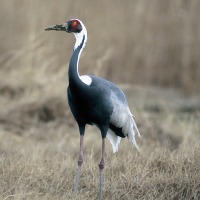 |
White-naped Crane (Grus vipio)
MANAZURU
Habitat: Agricultural lands in lowlands in Honshu, Shikoku and Kyushu. Winter visitor, but mainly comes to Kagoshima Prefecture in Kyushu and a rare vagrant in Honshu. Can be distinguished from Hooded Crane and Crane (or Common Crane) by bigger-size and red part around eyes.
Voice: Call is in lower and louder voice than Hooded Crane but difficult to distinguish by voice.
See more
♪ call: K Kajimoto
|
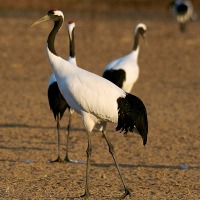 |
Red-crowned Crane (Grus japonensis)
TANCHOU
Habitat: Lakes, rivers and wetlands in Hokkaido, but occasionally recorded in Honshu. Resident.
Voice: Calls ka, kaa kaa, ka (kyoa kyoa) in deep and loud voice. Rarely confused with other species due to its distinguishing appearance.
♪ alarm?: H Kuroda
♪ alarm?: H Kuroda
|
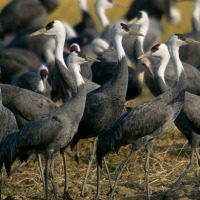 |
Hooded Crane (Grus monacha)
NABEZURU
Habitat: Agricultural lands in Honshu, Shikoku and Kyushu. Winter visitor, but quite locally distributed in Honshu and Shikoku. Often in flocks. Crane/Common Crane looks similar, but can be distinguished from it by white neck and grayish black body. White-naped Crane is much bigger.
Voice: Hard to distinguish from other crane species by voice.
See more
♪ call: K Kajimoto
|
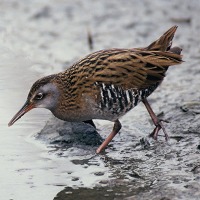 |
Water Rail (Rallus aquaticus)
KUINA
Habitat: Grassy areas along lakes and rivers and marshes from lowlands to mountainous areas. Lives in the north of Kanto and to the north year long, but seen from October through April, in the south of Kanto and to the south.
Voice: Various kwee ket ket ket or keet keet as well as repeating kuin kuin. Often utters from the evening until early morning. Sometimes too similar to the sound of Moorhen (or Common Moorhen) to distinguish the two species.
♪ call: T Hirano ♪ call: T Hirano
♪ call: T Hirano ♪ call: T Hirano
|
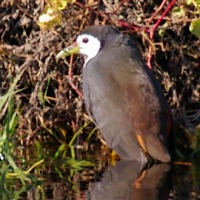 |
White-breasted Waterhen (Amaurornis phoenicurus)
SHIROHARAKUINA
Habitat: Nansei-shoto islands. Breeding recorded in Honshu recently. Resident. Conspicuously white from the face to the belly.
♪ call: K Kajimoto
♪ call: T Moriya
|
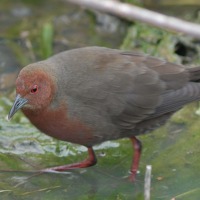 |
Ruddy-breasted Crake (Porzana fusca)
HIKUINA
Habitat: Waterside grassy areas around lakes, rivers, rice paddies and wetlands from lowlands to mountainous areas, but few in eastern Japan. Can be seen through the year in central Honshu and to the south while from April to October in central Honshu and to the north.
Voice: Calls from spring to summer, in the morning and evening, distinctive descending call kyoi kyoi kyokyokyo buruburu like someone’s knocking at a door, known as ‘Crake’s knocking’ in Japan. Also gyururururu like Little Grebe, which is higher and stronger than Crake.
♪ call: T Hirano ♪ call: T Hirano ♪ threat: T Hirano
|
 |
Common Moorhen (Gallinula chloropus)
BAN
Habitat: Lakes, rivers, rice paddies, ponds and in grassy areas on wetlands from lowlands to mountainous areas throughout Japan year round. Resident. Northern population moves to warmer regions in winter.
Voice: Kru or kee kee kee kee call which is similar to bullfrog. The voice of the bird is louder and stronger. Kru call is similar to bullfrogs. Kee kee sound is similar to and often hard to distinguish from Water Rail.
♪ call: T Hirano
♪ call: K Kajimoto
|
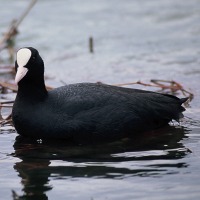 |
Eurasian Coot / Common Coot (Fulica atra)
OOBAN
Habitat: Lakes and marshes, harbors and rivers from lowlands to mountainous areas in Hokkaido and to the south, but breeds only locally. Sometimes seen a flock of hundreds in winter.
Voice: Calls kyon loudly.
♪ call: T Hirano
|
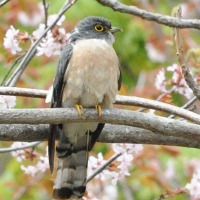 |
Rufous Hawk Cuckoo / Horsfield's Hawk-cuckoo
(Hierococcyx hyperythrus)
JUUICHI
Habitat: Mostly woodlands in mountainous areas throughout Japan. Summer visitor. Appears in deciduous woods in lowlands during migration seasons.
Voice: Repeats jyuuichee jyuuichee loudly and chatters variously like jihihihi. Flies actively even at night calling.
See more
♪ song: T Hirano ♪ odd vocalization: K Kajimoto
|
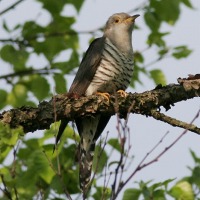 |
Little Cuckoo / Lesser Cuckoo (Cuculus poliocephalus)
HOTOTOGISU
Habitat: Woodlands from lowlands to mountainous areas throughout Japan. Summer visitor.
Voice: Either on top of a tree or flying high, it repeats the call that’s your cho-ky pepper or tep pen kaketaka(means : lost your hair on top?)or tokkyo kyokakyoku (means: license office). Loudly calls even at night. Sometimes its call can be heard from the sky over residential areas and agricultural lands.
♪ song: M Ueta
♪ call: K Kajimoto
|
 |
Indian Cuckoo (Cuculus micropterus)
SEGUROKAKKOU
♪ song: N Wada
|
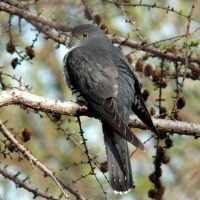 |
Oriental Cuckoo (Cuculus optatus)
TSUTSUDORI
Habitat: Woodlands from lowlands to mountainous areas throughout Japan. Seen at parks in residential areas in migration seasons. Summer visitor. Earliest comer among Cuckoos.
Voice: From the middle of April in monotone po po po po po. No birds call like this.
♪ song: T Hirano
♪ call: K Kajimoto
|
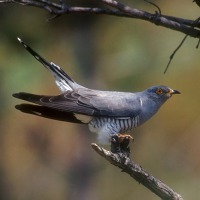 |
Common Cuckoo (Cuculus canorus)
KAKKOU
Habitat: Pen woods, wild areas, agricultural lands and residential areas from lowlands to mountainous areas throughout Japan.
Voice: Calls kakkou kakkou repeatedly and kyo kyo kyokyo kyo loudly in the end. Its voice resembles no others.
♪ song: M Ueta ♪ call: T Hirano
♪ fight: T Hirano
|
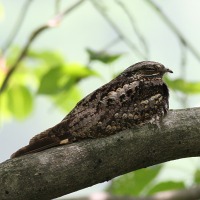 |
Jungle Nightjar (Caprimulgus indicus)
YOTAKA
Habitat: Woodlands deciduous woods and open woods in dry riverbeds from lowlands to mountainous areas throughout Japan. Summer visitor.
Voice: Calls monotonous and continuous kyokyokyokyokyo (gyo gyo gyo gyo gyo) after sunset.
♪ song: M Ueta
♪ song: T Hirano
|
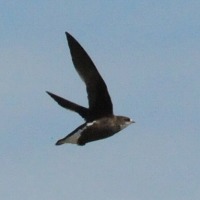 |
White-throated Needletail (Hirundapus caudacutus)
HARIOAMATSUBAME
Habitat: From lowlands to high mountains throughout Japan. Transients or summer visitor. In breeding season, small number seen in forests on subalpine zones in central Japan to the north, and common in woods from lowlands to mountainous areas in Hokkaido. In October migration season, they fly around high in the sky even over agricultural lands and urban areas in lowlands in Honshu and to the south. Can be distinguished from Swift/ Pacific Swift in flight, as the bird is bigger with rounder wing tips and without white rump.
♪ call: H Kuroda
|
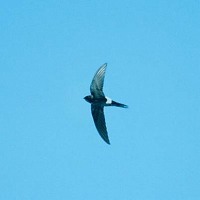 |
Fork-tailed Swift/Pacific Swift (Apus pacificus)
AMATSUBAME
Habitat: From seashores to rocky stretches in alpine zones throughout Japan. Summer visitor. Seen even over residential areas during spring (April) and autumn (September to October) migration seasons.
Voice: Softly, chree or uree
♪ call: R Kurosawa
♪ flock: R Kurosawa
|
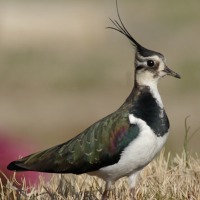 |
Northern Lapwing (Vanellus vanellus)
TAGERI
♪ call: H Kuroda
♪ call: H Kuroda
|
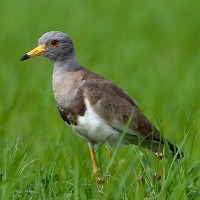 |
Grey-headed Lapwing (Vanellus cinereus)
KERI
♪ alarm: H Kuroda
♪ attack: H Kuroda
See more |
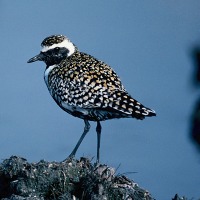 |
Pacific Golden Plover (Pluvialis fulva)
MUNAGURO
Habitat: Tidal flats, rivers and agricultural lands in lowlands throughout Japan. Passage migrant or winter visitor. From face to belly is black during spring migration season and light brown during autumn-winter season.
Voice: Calls tu ee, kyo bee or chu veee (pyui poi). Can be distinguished from similar looking Grey Plover /Black-bellied Plover which gives a slightly drawling call as pleee you ee or tyu eer leee (pyohee).
♪ call: H Kuroda ♪ call: H Kuroda
♪ call: H Kuroda ♪ call: M Ueta
|
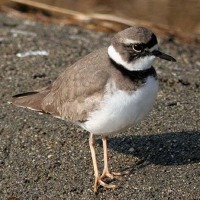 |
Long-billed Plover (Charadrius placidus)
IKARUCHIDORI
Habitat: Gravel grounds around lakes and rivers from lowlands to mountainous areas throughout Japan all year round. Rare in tidal flats near the seashores.
Voice: Call is repeated loud pewee (peeo peeo) in flight at breeding sites starting in March. Little Ringed Plover, which occurs in similar habitats, gives a similar call but with lower volume and continuous call pipipipipi or tau tau tau in flight.
See more
♪ call: T Hirano ♪ alarm: T Hirano
|
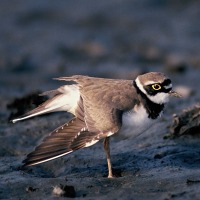 |
Little Ringed Plover (Charadrius dubius)
KOCHIDORI
Habitat: Sand and gravel areas of coasts, lakes and rivers in lowlands throughout Japan. Common summer visitor. Sometimes it builds a nest in graveled parking or empty lots. During migration, seen in agricultural lands like fallow rice fields.
Voice: Calls pipipipi continuously or pyuu pyuu separately. Can be easily distinguished from Long-billed Plover whose call is louder and clearer.
♪ call: T Hirano
♪ call: T Hirano
|
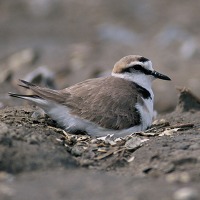 |
Kentish Plover (Charadrius alexandrinus)
SHIROCHIDORI
Habitat: Tidal flats and large rivers with sandbars from coasts to lowlands throughout Japan. Resident. Rare at in mountainous areas.
Voice: When a human comes closer, calls pryui, pryuri or kpi,kpi, flying around. Looks like Little Ringed Plover and Long-billed Plover, but the bird does not utter so clearly as these species.
♪ call: T Hirano
|
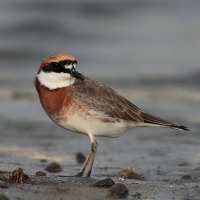 |
Lesser Sand Plover (Charadrius mongolus)
MEDAICHIDORI
♪ call: H Kuroda
|
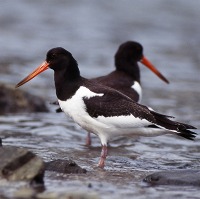 |
Eurasian Oystercatcher (Haematopus ostralegus)
MIYAKODORI
♪ call: T Moriya
♪ call: T Moriya
|
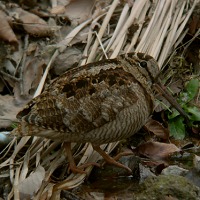 |
Eurasian Woodcock (Scolopax rusticola)
YAMASHIGI
Habitat: Woodlands, deciduous woods and open woods in dry riverbeds from lowlands to mountainous areas throughout Japan. Resident. Breeding is limited to Hokkaido and central Honshu and to the north.
Voice: In breeding season, flies around over woods giving buu buu buu buu or chiki chiki chiki (peejun) or kyu kyu kyu notes from the evening. Rarely calls in autumn and winter.
♪ call: H Kuroda
|
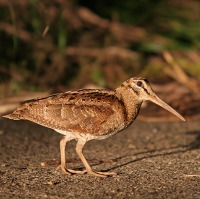 |
Amami Woodcock (Scolopax mira)
AMAMIYAMASHIGI
Habitat: Dense broad-leaved evergreen forests on Amamishoto islands, Okinawa-honto and Kerama-shoto islands year round. During the daytime rests within forests, and comes out to feed on open fields such as agricultural lands at night.
Voice: Call is gboo gboo gee gee while in flight during the breeding season. Gweh when taking off.
See more
♪ call: K Kajimoto
|
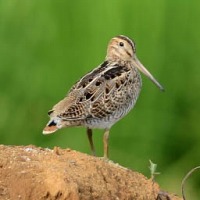 |
Latham's Snipe (Gallinago hardwickii)
OOJISHIGI
Summer visitor. Locally distributed in central Honshu and to the south. Also in tidal flats near the coast during migration seasons.
Voice: In breeding sites, repeated call, jeep jeep zubiyaku zubiyaku on the ground, shrubs or on utility poles. Performing flight displays, flies around then dives flapping its wings to create sound za za za za. Another name is Kaminari-shigi, Thunder Snipe.
See more
♪ song: K Kajimoto ♪ song: K Kajimoto
|
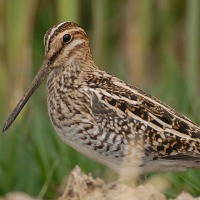 |
Common Snipe (Gallinago gallinago)
TASHIGI
♪ call: H Kuroda
♪ call: H Kuroda
|
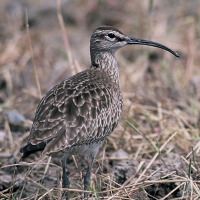 |
Whimbrel (Numenius phaeopus)
CHUUSHAKUSHIGI
♪ call: H Kuroda
♪ call: T Moriya
♪ flight call: H Kuroda
|
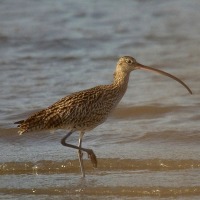 |
Eastern Curlew (Numenius madagascariensis)
HOUROKUSHIGI
Habitat: Tidal flats near the seashores throughout Japan. Passage migrant or winter visitor. A large Curlew with long legs and down-curved bill. Can be easily distinguished from Eurasian Curlew, whose appearance and habitat is similar, by the brown rump which appears in flight.
Voice: Hoo ii nn (hoh wee) without repeated phrases at the end of a call like Eurasian Curlew.
See more
♪ call: T Moriya
|
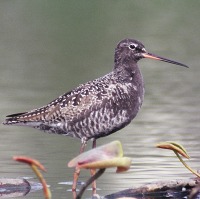 |
Spotted Redshank (Tringa erythropus)
TSURUSHIGI
♪ call: H Kuroda
♪ call: H Kuroda
|
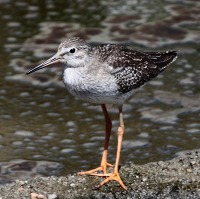 |
Common Redshank (Tringa totanus)
AKAASHISHIGI
♪ call: H Kuroda
|
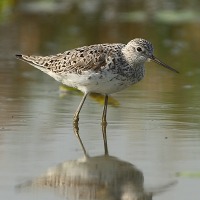 |
Marsh Sandpiper (Tringa stagnatilis)
KOAOASHISHIGI
♪ call: T Moriya
|
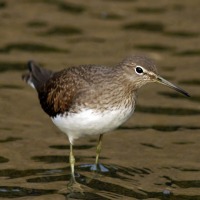 |
Green Sandpiper (Tringa ochropus)
KUSASHIGI
♪ call: T Hirano
|
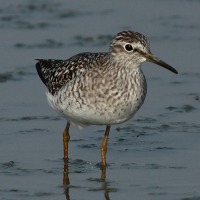 |
Wood Sandpiper (Tringa glareola)
TAKABUSHIGI
♪ call: T Moriya
|
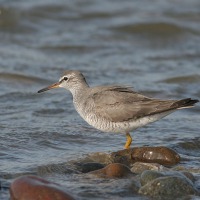 |
Grey-tailed Tattler (Heteroscelus brevipes)
KIASHISHIGI
Habitat: Coastal sand beaches, tidal flats, inland rivers, lakes, ponds, and agricultural lands throughout Japan mostly as a passage migrant during migration seasons from April to May and from August to November. Visits rice paddies after rice planting.
Voice: Call is pyu ii or tuee dee.
♪ call: H Kuroda
♪ call: H Kuroda
|
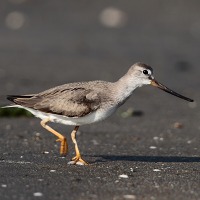 |
Terek Sandpiper (Xenus cinereus)
SORIHASHISHIGI
♪ call: H Kuroda
|
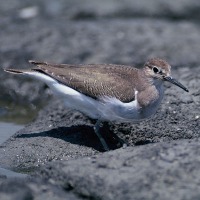 |
Common Sandpiper (Actitis hypoleucos)
ISOSHIGI
Habitat: Midstream areas and lakes in lowlands throughout Japan. Those in northern Japan move to warmer regions in winter.
Voice: In April-May, flies around the surface of rivers with a loud call sweedidee sweedidee (pee chiri pee chiri). In alarm, loud call repeatedly as wee wee wee, hee hee hee or chee ree ree (peee peee).
♪ call: T Hirano ♪ call: T Hirano ♪ call: K Kajimoto
|
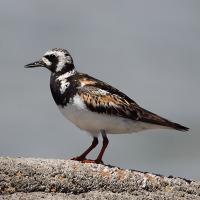 |
Ruddy Turnstone (Arenaria interpres)
KYOUJOSHIGI
♪ call: M Ueta
|
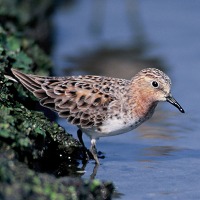 |
Red-necked Stint (Calidris ruficollis)
TOUNEN
♪ call: H Kuroda
♪ call: H Kuroda
|
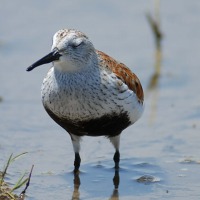 |
Dunlin (Calidris alpina)
HAMASHIGI
Habitat: Coastal tidal flats, upstreams with extensive gravel grounds, lakes and marshes throughout Japan. Winter visitor. Large number often can be seen swirling over tidal flats in synchronized flight with sudden turns when surprised.
Voice: Biryoo, biree.
♪ call: H Kuroda
♪ call: H Kuroda
|
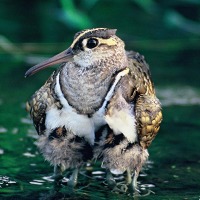 |
Greater Painted-snipe (Rostratula benghalensis)
TAMASHIGI
Habitat: Mainly in open areas of short grass around paddy fields, rivers and lakes in lowlands in Honshu and to the south. Resident. Those in northern Japan move to warmer regions in winter.
Voice: Koh koh koh (kohn kohn) at night or in early morning during breeding season.
♪ call: H Kuroda
♪ female: K Oshiro
♪ male: K Oshiro
|
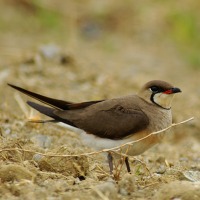 |
Oriental Pratincole (Glareola maldivarum)
TSUBAMECHIDORI
♪ call: H Kuroda
|
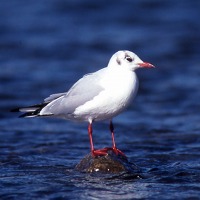 |
Black-headed Gull (Larus ridibundus)
YURIKAMOME
Habitat: Seashores, lakes and rivers in lowlands throughout Japan. Winter visitor. A small size gull. Whole body white except black wing tips in autumn and winter and bills and legs are red. Head becomes black in spring.
Voice: Continuous kyaar or krreearr or gyaa gyaa in husky voice.
♪ call: K Kajimoto
♪ call: K Kajimoto
|
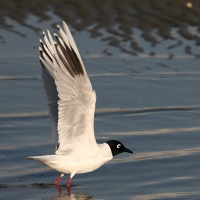 |
Saunders's Gull (Larus saundersi)
ZUGUROKAMOME
♪ call: H Kuroda
♪ call: H Kuroda
|
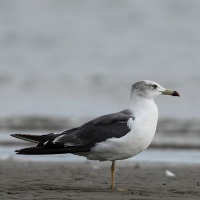 |
Black-tailed Gull (Larus crassirostris)
UMINEKO
♪ call: M Ueta
|
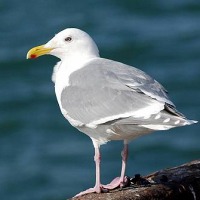 |
Glaucous-winged Gull (Larus glaucescens)
WASHIKAMOME
♪ call: M Ueta
|
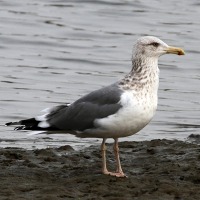 |
European Herring Gull (Larus argentatus)
SEGUROKAMOME
♪ call: M Ueta
|
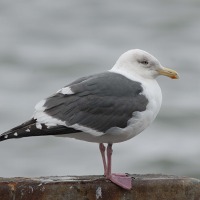 |
Slaty-backed Gull (Larus schistisagus)
OOSEGUROKAMOME
Habitat: Seashores, rivers, tidal flats and harbors, etc. throughout Japan, In Honshu and to the south. Winter visitor. A large sized gull. Distinguishable from Herring Gull, which occurs in similar environments, by darker colored back and upper wings.
♪ call: M Ueta
|
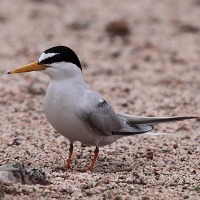 |
Little Tern (Sterna albifrons)
KOAJISASHI
Habitat: Sand and gravel areas of coasts and rivers in lowlands in Honshu and to the south. Summer visitor. Can be seen when it plunge-dives for fish to the water surface.
Voice: Calls kyi kyi, kei and kyik or kiri kyik kiri kyik (kyuri or kiri)in flight.
♪ call: T Hirano
|
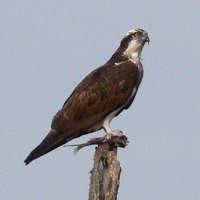 |
Western Osprey (Pandion haliaetus)
MISAGO
Habitat: Seashores, large lakes and rivers throughout Japan. Catches fish by plunging into the water after hovering in the air. Often observed in inland waters on its migration way as well as in autumn and winter.
Voice: Calls pyo pyo pyo or pii pii in flight.
♪ call: H Kuroda ♪ call: H Kuroda
♪ duet: K Kajimoto
|
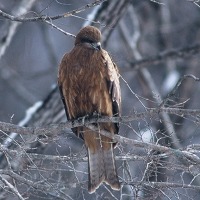 |
Black Kite (Milvus migrans)
TOBI
Habitat: Agricultural lands, woods, watersides and urban areas from coasts to mountainous areas throughout Japan. Common resident.
Voice: Calls piihyoro hyoro hyororo in laid-back and plaintive voice on a power pole, tree branch or in flight. Easy to distinguish from other raptors by voice.
♪ call: T Hirano
|
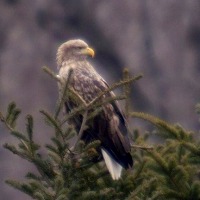 |
White-tailed Eagle (Haliaeetus albicilla)
OJIROWASHI
Habitat: Lakes and seaside woods from lowlands to mountainous areas throughout Japan. Breeds only in Hokkaido.
Voice: Calls kyee kyee kyee or klee klee klee klee (kya kya kya) in loud and slightly muffled voice. Resembles Steller's Sea Eagle, winter visitor, which occurs in similar habitats, thus careful attention is required for identifying by voice. Can be easily distinguished by appearance because the bills of Steller’s Sea Eagle are thick and heavy, and a part of the wings is white.
♪ call: M Ueta
|
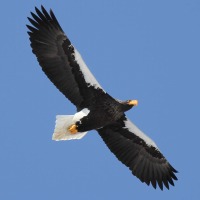 |
Steller's Sea Eagle (Haliaeetus pelagicus)
OOWASHI
Habitat: Lakes and near seashores from lowlands to mountainous areas throughout Japan, but population is small except in Hokkaido. Winter visitor. Adult Steller’s Sea Eagle has white patch on wings and thick and robust bills, which makes it easy to distinguish from White-tailed Eagle.
Voice: Calls in deep and high-pitched voice, but be careful as White-tailed Eagle gives similar call.
See more
♪ call: M Ueta
|
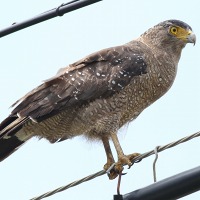 |
Crested Serpent Eagle (Spilornis cheela)
KAMMURIWASHI
Habitat: Woodlands facing rice paddies and marshes in Yaeyama-shoto islands including Ishigaki-jima island, Iriomote-jima island and Yonaguni-jima island. Immature bird is whitish grey. Bigger than crow and shows broad wings in flight.
Voice: Screams cook cook ku, or peer peer in high-pitched, loud voice.
See more
♪ call: T Moriya
♪ call: K Kajimoto
|
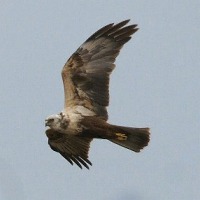 |
Eastern Marsh Harrier (Circus spilonotus)
CHUUHI
Habitat: Mainly extensive reed beds at lakes and marshes, rivers and seashores in lowlands throughout Japan. Often glides over reed beds with wings in V shape.
Voice: Calls mibya, mibya or kya kya kya kya kya loudly. Early spring flies high in the sky and utters kuke, kuke.
See more
♪ call: T Hirano ♪ call: T Hirano
♪ alarm: T Hirano
|
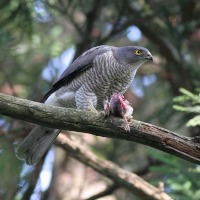 |
Japanese Sparrowhawk (Accipiter gularis)
TSUMI
Habitat: Woods from lowlands to mountainous areas throughout Japan. Resident. Breeds even in urban areas in Kanto. Smaller than doves.
Voice: Calls from early spring to autumn pyo , pyo pyo pyo with a falling note. Females and fledglings call ket ket ket ket continuously. In early spring, Eurasian Jay imitates the voice, but Eurasian Jay often calls jah jah after that.
See more
♪ male: M Ueta
♪ female: T Hirano
♪ femalethreat: T Hirano
♪ begging: T Hirano
|
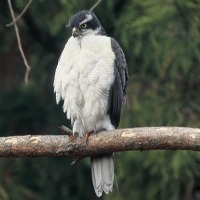 |
Northern Goshawk (Accipiter gentilis)
OOTAKA
Habitat: Woodlands, agricultural lands, and open woods in dry riverbeds from lowlands to mountainous areas throughout Japan. Crow size.
Voice: Call is kya kya kya kya, kee kee kee kee or kyik kyik kyik (ket ket ket) in loud tone or pyii in drawling tone at breeding sites from early spring to early summer. Can be distinguished from Common Buzzard, which gives similar but stronger and more prolonged pyiiaa call. Eurasian Jay mimics the call but follows up with gsharrr (jah jah) note.
♪ alarm: T Hirano
♪ begging: M Ueta
♪ call: T Hirano
♪ juvenile: H Kuroda
|
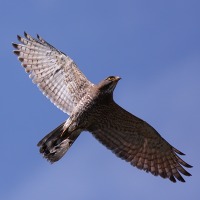 |
Grey-faced Buzzard (Butastur indicus)
SASHIBA
Habitat: Around agricultural lands from lowlands to mountainous areas in Honshu and to the south. Summer visitor. Especially prefers hilly areas which have rice paddies along streams.
Voice: Pik wee, pik kwee while perching on trees or power poles or in flight from the end of March to July. Eurasian Jay sometimes mimics the call in early spring, but Jay’s call often follows with gsharrr gsharrr (jar jar) sound.
See more
♪ call: M Ueta
|
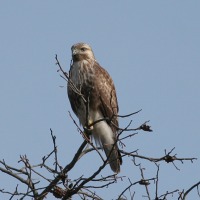 |
Common Buzzard /Buzzard (Buteo buteo)
NOSURI
Habitat: Forests and grasslands from lowlands to mountainous areas throughout Japan. Can be observed in dry riverbeds and agricultural lands in the suburbs of cities in autumn and winter.
Voice: Calls kiiii kiiii (pee ah) repeatedly in melancholy and slightly drawling tone.
♪ call: T Hirano
♪ call: H Kuroda
♪ feeding: H Kuroda
|
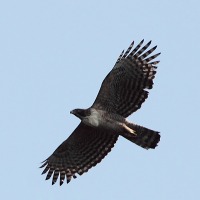 |
Mountain Hawk-Eagle (Nisaetus nipalensis)
KUMATAKA
♪ call: H Kuroda
See more |
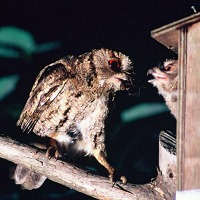 |
Sunda Scops Owl (Otus lempiji)
OOKONOHAZUKU
Habitat: Woodlands, open woods and parks from lowlands to mountainous areas throughout Japan. Resident, but uncommon.
Voice: Call is continuous won won and kyan kyan during breeding season..
♪ call: S Abe
|
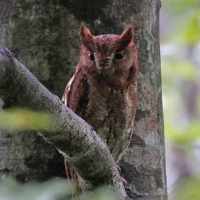 |
Oriental Scops Owl (Otus sunia)
KONOHAZUKU
Habitat: Woodlands from low to high mountainous areas throughout Japan. Summer visitor.
Voice: Sings in repetitive buk kyok koo (ho kyok kyo) or bu po so (means Buddha-the teachings of Buddhism-a Buddhist priest).
♪ call: H Kuroda
|
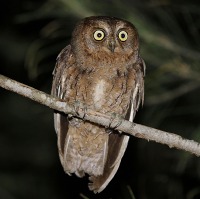 |
Ryukyu Scops Owl (Otus elegans)
RYUUKYUUKONOHAZUKU
Habitat: Forests in Nansei-shoto islands.
Voice: Repeats call ko ho ko ho (koporoh koporoh).
See more
♪ call: T Moriya
♪ call: K Kajimoto
|
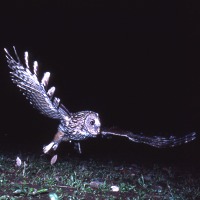 |
Ural Owl (Strix uralensis)
FUKUROU
Habitat: Woodlands from lowlands to mountainous areas throughout Japan year round. Common resident. In autumn and winter, occurs also in small deciduous woods, etc.
Voice: Starts to sing at night around February, goro ho hho or hohohohoho like a groan. Calls sometimes like animals, gya.
♪ call: T Hirano
♪ call: T Hirano
♪ call: M Ueta
|
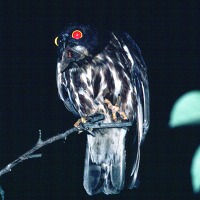 |
Brown Hawk-Owl (Ninox scutulata)
AOBAZUKU
Habitat: Woodlands, agricultural lands and dense woods around temples, shrines and large private housing lots, from lowlands to mountainous areas throughout Japan. Summer visitor. The commonest owl species in Japan.
Voice: Starts singing in May, repeating hoh hoh sound continuously at night.
♪ call: T Hirano
|
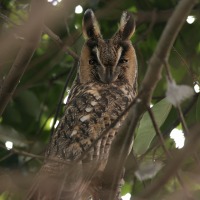 |
Long-eared Owl (Asio otus)
TORAFUZUKU
Habitat: Woodlands, agricultural lands, dry riverbeds and residential areas from lowlands to mountainous areas throughout Japan. Resident or winter visitor.
Voice: Boo boo boo (wo ho ho ho) but rarely utters. Fledglings call kee kee or mee or hee in melancholic and metallic note which resembles the call of Scaly Thrush but sounds more metallic.
♪ fledgling: T Hirano
|
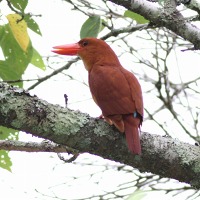 |
Ruddy Kingfisher (Halcyon coromanda)
AKASHOUBIN
Habitat: Dense forests from low to high altitude mountainous areas along valleys all through Japan. Summer visitor. Uncommon.
Voice: Sings pyorororoh, pyorororoh repeatedly, or high-pitched kya kya kya. At nesting site, sings before dawn to sunrise especially on rainy days.
♪ call: M Ueta
|
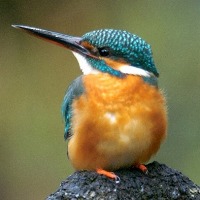 |
Common Kingfisher (Alcedo atthis)
KAWASEMI
Habitat: Rivers, lakes and ponds in parks from lowlands to mountainous areas throughout Japan year round.
Voice: Calls peeet or tiii and tee titi titi (kiririri) in high note.
♪ call: T Hirano
|
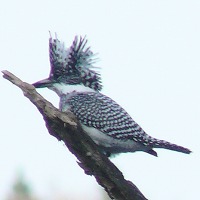 |
Crested Kingfisher (Megaceryle lugubris)
YAMASEMI
Habitat: Rivers and lakes with cliffs from lowlands to mountainous areas throughout Japan. Resident. Hunts to dive from perch.
Voice: High piercing ket ket or kyara kyara.
♪ call: S KASAHARA
|
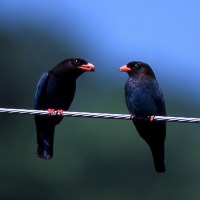 |
Oriental Dollarbird (Eurystomus orientalis)
BUPPOUSOU
Habitat: Woodlands from lowlands to mountainous areas from Honshu and to the south. Summer visitor. A small number occurs locally from central Honshu and to the north.
Voice: Ge ge gegegegegege. No other resembling species from its appearance and voice.
♪ call: H Kuroda
♪ juvenile: H Kuroda
|
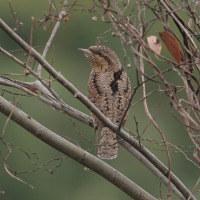 |
Eurasian Wryneck (Jynx torquilla)
ARISUI
Habitat: Woodlands, deciduous woods and reedbeds from lowlands to mountainous areas throughout Japan. Winter visitor. Seen in reedbeds and shrubs in central Honshu and to the south. As a summer visitor, occurs in open woods, windbreak forests and at edge of woodlands in Hokkaido and northern Honshu.
Voice: Loud and noisy call, kya kya kya.
♪ call: K Kajimoto
|
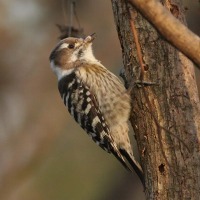 |
Japanese Pygmy Woodpecker (Dendrocopos kizuki)
KOGERA
Habitat: Woodlands, parks and open woods in dry riverbeds from lowlands to mountainous areas throughout Japan all year long. Also commonly seen in parks and on roadside trees in urban areas. A woodpecker species in the similar size as Tree Sparrow.
Voice: Calls kzzz kzzz (gee gee) or khit khit khit moving on trunks and branches of trees. Korokorokoro by pecking at the trunk of a tree.
See more
♪ call: M Ueta
♪ call: T Hirano
♪ drumming: T Hirano
♪ fledgling: K Kajimoto
|
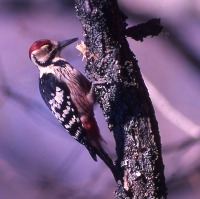 |
White-backed Woodpecker (Dendrocopos leucotos)
OOAKAGERA
Habitat: Woodlands from low mountains to mountainous areas throughout Japan. Resident. Rare around residential areas.
Voice: Ke ke ke and pecks dead trees to create a sound, called drumming. Distinguished from Great Spotted Woodpecker in Honshu and Hokkaido, by the dark brown streaks from the breast to flank and white patterns that seem like thin stripes on the back. Difficult to distinguish only by their voices.
♪ call: M Ueta
♪ drumming: T Hirano
|
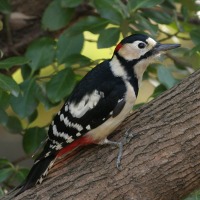 |
Great Spotted Woodpecker (Dendrocopos major)
AKAGERA
Habitat: Woodlands from lowland to mountainous areas in the north of Honshu all year round. Seen in small woods on dry riverbeds, agricultural lands and parks in autumn and winter.
Voice: Kett, kett kett and drums on dead trees. Resembles White-backed Woodpecker. Great Spotted Woodpecker has diagonal white patches from the back to the wings, while White-backed Woodpecker has thin stripes on wings and blackish brown streaks from breast to the sides. Impossible to identify the two species by their calls alone.
♪ call: M Ueta
♪ drumming: T Nanba
♪ juvenile: T Nanba
|
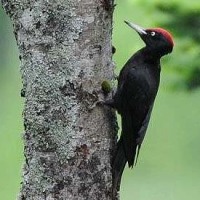 |
Black Woodpecker (Dryocopus martius)
KUMAGERA
Habitat: Woodlands from lowlands to mountainous areas in Hokkaido all year. A few live in the mountains in a part of Tohoku.
Voice: Kehn kehn in a high-pitched voice and also repeating hee hee hee. Drums on tree trunks, too. No other species sings similarly.
♪ call: K Kajimoto
♪ drumming: T Nanba
♪ drumming: T Nanba
|
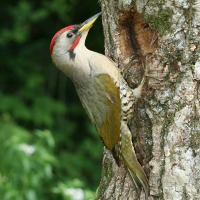 |
Japanese Green Woodpecker (Picus awokera)
AOGERA
Habitat: Woodlands, from lowlands to mountainous areas in Honshu and to the south year round. In autumn and winter, occurs even in deciduous woods in residential areas and parks as well. Drums on dead trees. No similar species in appearance.
Voice: Resembles Great Spotted Woodpeckers and White-backed Woodpeckers, but identifiable by que la la la, or sharp pyoh pyoh pyoh. The pyoh sound resembles the food begging voice of Goshawk/Northern Goshawk, but repetition of the shorter pyo sounds enable to distinguish the species from others.
♪ call: M Ueta
♪ call: T Hirano ♪ call: T Hirano
♪ drumming: M Ueta
♪ odd vocalization: K Kajimoto
|
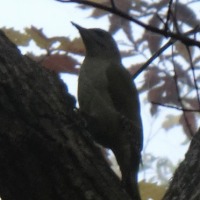 |
Grey-headed Woodpecker (Picus canus)
YAMAGERA
Habitat: Woodlands from lowlands to mountainous areas in Hokkaido.
Voice: In addition to the call kik kik kik like other woodpeckers, gives loud pyo pyopyopyopyo (kyo kyo kyo kyo) notes. Ruddy Kingfisher also gives similar loud call, but can distinguish from this species as the woodpecker gives short kik kik note too.
♪ call: R Kurosawa
♪ drumming: R Kurosawa
|
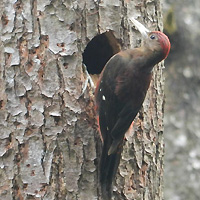 |
Okinawa Woodpecker (Sapheopipo noguchii)
(Dendrocopos noguchii)
NOGUCHIGERA
♪ call: T Moriya
|
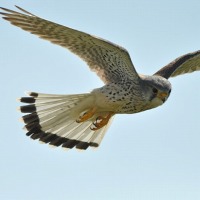 |
Common Kestrel (Falco tinnunculus)
CHOUGEMBOU
Habitat: Open areas such as grasslands, agricultural lands, dry riverbeds and urban areas from lowlands to mountainous areas throughout Japan. Resident.
Voice: Calls kya, kya, kya in high tone and sometimes feeble kee kee. Can be distinguished from Peregrine Falcon that calls in thick louder voice.
♪ alarm: T Hirano
♪ copulation: T Hirano
|
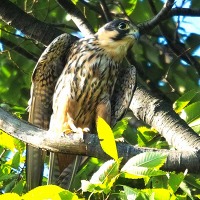 |
Eurasian Hobby (Falco subbuteo)
CHIGOHAYABUSA
Habitat: Forests, agricultural lands, grasslands, dry riverbeds and woods around shrines and temples from lowlands to mountainous areas throughout Japan. Summer visitor. Breeding mostly limited to northern Honshu and Hokkaido.
Voice: High pitched klee klee klee or kew kew kew. Similar to Common Kestrel, that is weaker, while Peregrine Falcon is deeper.
♪ call: K Mikami
|
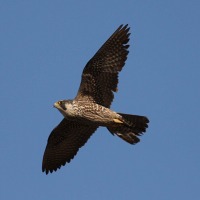 |
Peregrine Falcon (Falco peregrinus)
HAYABUSA
Habitat: Agricultural lands, rivers, lakes and marshes, urban areas from coasts to mountainous areas throughout Japan. Quite often seen in autumn and winter, even with small population.
Voice: High voice, kee kee kee. Stronger and louder than Kestrel/Common Kestrel and Hobby/ Eurasian Hobby.
♪ call: R Kurosawa
♪ juvenile: H Kuroda
♪ juvenile: R Kurosawa
|
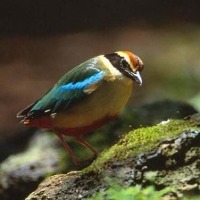 |
Fairy Pitta (Pitta nympha)
YAIROCHOU
Habitat: Locally mountain forests in Honshu and to the south. Summer visitor. Eats insects and earthworms foraging on the ground. Easily identified by its characteristic feather colors.
Voice: Song is easy to distinguish by its repetitive carrying song pee yu pee yu or pwo heh wo heh(popohoee popohoee).
♪ song: E Uematsu
|
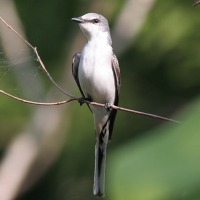 |
Ashy Minivet (Pericrocotus divaricatus)
SANSHOUKUI
Habitat: Woodlands from lowlands to mountainous areas throughout Japan. Resident or summer visitor. Prefers woods on rough terrain. Passes over urban areas singing/calling during migration.
Voice: Song is hirihirihirihirin, clear and continuous note. Sub-species Ryukyu Minivet seen in western Japan is resident and the call is huskier voice without intonation than sub-species Ashy Minivet.
♪ call: K Kajimoto
|
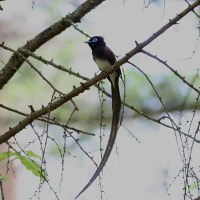 |
Japanese Paradise Flycatcher (Terpsiphone atrocaudata)
SANKOUCHOU
Habitat: Forests and deciduous forests from lowlands to mountainous areas in Honshu and to the south. Summer visitor. Seen in parks in residential areas in migration seasons in spring and autumn. Male flies around in forests waving its long tail.
Voice: Song is three-syllable chitter followed by fast, whistling tsuki hee hoshi hoy hoy hoy. This is characteristic melody which is easy to distinguish. Calls gii or bii (gee gee or jeh jeh) in thick tone.
♪ song: K Kajimoto
♪ call: K Kajimoto
|
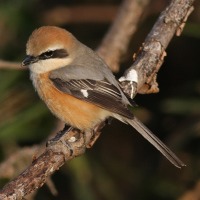 |
Bull-headed Shrike (Lanius bucephalus)
MOZU
Habitat: Open woods, agricultural lands, grasslands and dry riverbeds from lowlands to mountainous areas throughout Japan. Resident. Those in snow-covered areas move to warmer regions in winter.
Voice: Actively sings kyiikyiikyiikyii on top of a tree or antenna from around September. In addition to repeated call chikichikichiki (gichi gichi gichi) mimics voice of other species and sings complicated sound in small voice. Brown Shrike calls in lower voice.
See more
♪ autumn territorial song: T Hirano
♪ call: T Hirano
♪ subsong: K Kajimoto
♪ mimic: T Hirano
|
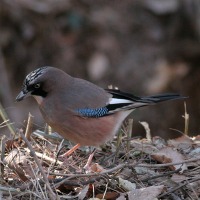 |
Eurasian Jay (Garrulus glandarius)
KAKESU
Habitat: Woodlands, deciduous woods and agricultural lands from lowlands to mountainous areas throughout Japan. Also seen in woods even near human dwellings in lowlands in autumn and winter.
Voice: Calls jah jah or gyah gyah loudly. In early spring, mimics many birds like Goshawk, Japanese Sparrowhawk and Grey-faced Buzzard, but can be distinguished, as jah jah sound is mixed in.
♪ call: T Hirano
♪ mimic: K Kajimoto ♪ mimic: T Hirano
♪ mimic: T Hirano ♪ mimic: T Hirano
♪ mimic: H Kuroda ♪ subsong: T Hirano
|
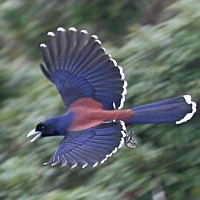 |
Lidth’s Jay (Garrulus lidthi)
KAKESU
Habitat: Forests in Amami-ohshima island, Kakeroma-shima island, Uke-shima island and Edateku-jima island. Resident. Easy to identify by its unique lazuline colored plumage.
Voice: Easy to distinguish its call from the similar call of Eurasian Jay which occurs only in Kyushu and to the north.
See more
♪ call: K ISHIDA ♪ call:K ISHIDA
♪ nestlings: K ISHIDA
|
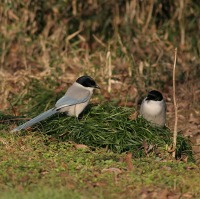 |
Azure-winged Magpie (Cyanopica cyanus)
ONAGA
Habitat: Open woods, agricultural lands, urban areas and dry riverbeds from lowlands to mountainous areas in central Honshu and to the north up to Tohoku Region. Resident. Often seen in flocks.
Voice: Call is gyuuui, geh, kyrururu (gehy gehy gey gey gey) loudly. No other species give a similar call.
♪ call: M Ueta
♪ alarm: M Ueta
|
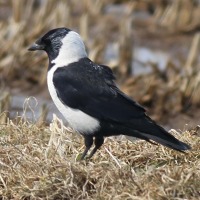 |
Daurian Jackdaw (Corvus dauuricus)
KOKUMARUGARASU
Habitat: Agricultural lands in lowlands in Honshu and Kyushu. Winter visitor. Crow species as large as a dove and often moves about in a flock of Rook.
Voice: Call ischyak (kyon kyon).Can be easily distinguished from other crow species.
♪ call: H Kuroda
|
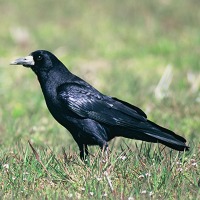 |
Rook (Corvus frugilegus)
MIYAMAGARASU
Habitat: Mainly agricultural lands in Honshu and to the south, but occasionally in Hokkaido. Winter visitor. Often in flocks in daytime and roosts in flocks at night.
Voice: Call is similar to Carrion Crow but can be distinguished by its hoarser voice.
♪ call: K Kajimoto
|
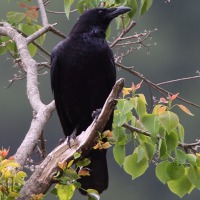 |
Carrion Crow (Corvus corone)
HASHIBOSOGARASU
Habitat: Open woods, agricultural lands, residential areas and dry riverbeds from lowlands to mountainous areas throughout Japan. Resident.
Voice: Lighter sound and huskier than Jungle Crow/Large-billed Crow. Similar to Rook which comes to agricultural lands in winter, but less husky.
♪ call: T Hirano
♪ fledgling: M Ueta
|
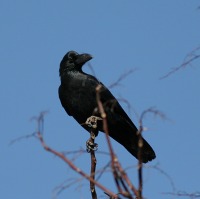 |
Jungle Crow / Large-billed Crow (Corvus macrorhynchos)
HASHIBUTOGARASU
Habitat: Woodlands, agricultural lands, urban areas, dry riverbeds and coasts from lowlands to mountainous areas throughout Japan. Resident. Many of them live in towns.
Voice: Louder and lower than Carrion Crow.
See more
♪ call: M Ueta
♪ fledgling: T Hirano
|
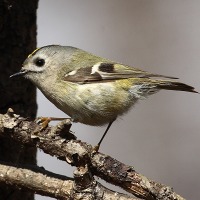 |
Goldcrest (Regulus regulus)
KIKUITADAKI
Habitat: Mountain forests all year long throughout Japan. In autumn and winter inhabits deciduous woods and parks in lowlands.
Voice: Metallic voice with complicated intonation .Repeated sree sree sree or shishii shishii in thin voice which is similar to Coal Tit and Long-tailed Tit, but Goldcrest calls without intonation. Can be identified as the call of Coal Tit combines tse tsu tsu chi in high tone.
♪ song: T Hirano
♪ call: T Nanba ♪ call: M Ueta
♪ call: T Hirano
♪ juvenile: T Hirano
|
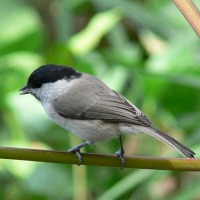 |
Marsh Tit (Poecile palustris)
HASHIBUTOGARA
Habitat: Woodlands, parks, deciduous broadleaf woods from lowlands to mountainous areas in Hokkaido. Very similar to Willow Tit in appearance.
Voice: Song is identifiable by Willow Tit’s slower and more cadent song, and more metallic than Willow Tit. Need care for identification.
♪ song: M Ueta
♪ song: T Nanba
♪ call: M Ueta
♪ call: R Kurosawa
|
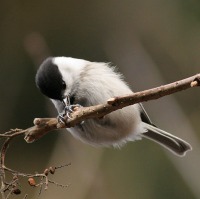 |
Willow Tit (Poecile montanus)
KOGARA
Habitat: Mountain woodlands throughout Japan all year long. Mainly lives in the beech wood forests at a higher altitude than the habitats of Japanese Tit and Varied Tit.
Voice: Calls chichi jeejee or phi t phi t in soft voice. Japanese Tit and Willow Tit give similar voice. Willow Tit gives a slightly slower and softer voice than Japanese Tit and Coal Tit.
♪ song: M Ueta
♪ call: T Hirano ♪ call: K Kajimot
♪ fledgling: K Kajimoto
|
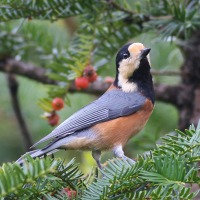 |
Varied Tit (Poecile varius)
YAMAGARA
Habitat: Woods from lowlands to mountainous areas throughout Japan. Resident. Common in warmer regions.
Voice: Slightly nasal. Japanese Tit and Willow Tit have similar voice. Both species sing in clearer voice than Varied, and Japanese Tit sings in faster tempo than Varied.
See more
♪ song: M Ueta
♪ call: M Ueta ♪ call: K Kajimoto
♪ call: K Kajimoto ♪ call: K Kajimoto
♪ courtship: K Kajimoto
♪ fledgling: K Kajimoto
|
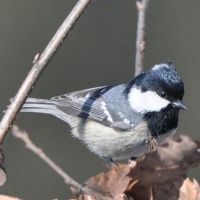 |
Coal Tit (Periparus ater)
HIGARA
Habitat: Woodlands in mountainous areas throughout Japan. Resident.
Voice: Song is similar to Great Tit/Japanese Tit and Willow Tit. Great/Japanese Tit sings lower and slower, and Willow Tit sings softer and much slower.
♪ song: M Ueta ♪ song: K Kajimoto
♪ call: M Ueta ♪ call: T Nanba
♪ call: T Hirano ♪ call: T Hirano
♪ alarm: T Hiran
|
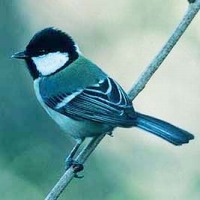 |
Japanese Tit / Great Tit (Parus minor)
SHIJUUKARA
Habitat: Woods from residential areas to mountainous areas throughout Japan. Resident.
Voice: Similar voice birds are Coal Tit, Willow Tit and Varied Tit. Coal Tit gives higher and faster voice than Japanese Tit. Willow Tit calls in higher and softer voice. Varied Tit sings in lower and slightly nasal voice.
♪ song: M Ueta ♪ song: M Ueta
♪ call: K Kajimoto ♪ call: K Kajimoto
♪ call: K Kajimoto ♪ call: K Kajimoto
♪ fledgling: T Hirano
|
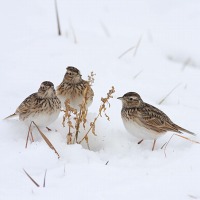 |
Skylark / Eurasian Skylark (Alauda arvensis)
HIBARI
Habitat: Dry riverbeds, agricultural lands, grasslands of short grass, rocky stretches from lowlands to mountainous areas throughout Japan. Resident. Moves to warmer regions in winter.
Voice: Sings from spring to summer, flies high up in the sky singing complicated songs, and flies around a while before it descends to the ground.
♪ song: M Ueta
♪ call: T Hirano
|
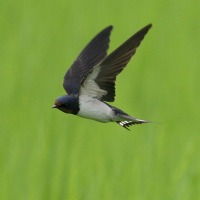 |
Barn Swallow (Hirundo rustica)
TSUBAME
Habitat: Open areas in towns and agricultural lands from lowlands to mountainous areas throughout Japan. Nests in houses. Common summer visitor. Simillar Red-rumped Swallow is bigger and has orange breast, and blackish vertical stripe from throat to flank.
Voice: Clearer than Red-rumped Swallow.
♪ call: M Ueta
♪ juvenile: K Kajimoto
♪ roost: M Ueta
|
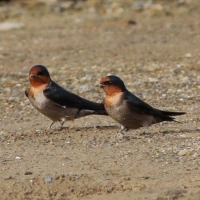 |
Pacific Swallow (Hirundo tahitica)
RYUUKYUUTSUBAME
Habitat: Residential areas, riversides and agricultural lands in Amami-ohshima island and to the south. Resident. Resembles Barn Swallow, but from front head to breast is chestnut color and outer tail feathers are not so long as Barn Swallow.
Voice: Similar to Barn Swallow.
♪ call: T Moriya
|
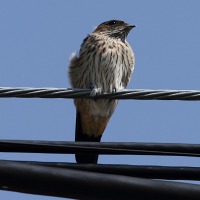 |
Red-rumped Swallow (Hirundo daurica)
KOSHIAKATSUBAME
Habitat: Locally in urban areas and agricultural lands in lowlands throughout Japan. Summer visitor. Glides more often than House Swallow (or Barn Swallow) when it flies around. Nest shape is like an evenly and vertically cut gourd.
Voice: Thicker than House Swallow.
♪ song?: K Kajimoto
♪ call: K Kajimoto
|
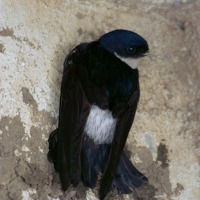 |
Asian House Martin (Delichon dasypus)
IWATSUBAME
Habitat: Commonly rural community areas, hot spring towns and agricultural lands from lowlands to mountainous areas throughout Japan. Summer visitor. More locally distributed than Barn Swallow, and nests in a group on buildings. Sometimes winters in Kanto Region and to the south. Flies around in a flock.
Voice: Call is thick juriri juri or ju ju piriri.
♪ call: M Ueta
|
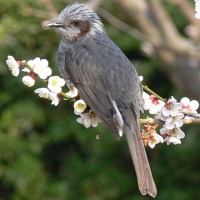 |
Brown-eared Bulbul (Hypsipetes amaurotis)
HIYODORI
Habitat: Woodlands, deciduous woods, parks, residential areas and dry riverbeds from lowlands to mountainous areas throughout Japan. Common resident. Makes a flock during migration.
Voice: Noisy high note as pipii hyara piyopiyopiyo. Calls sometimes in short notes as piiyy or shii which can cause mishearing with the call of Japanese Tit. Can be identified as Japanese Tit often calls continuously and contains the notes, juku juku juku.
See more
♪ call: T Nanba
♪ call: M Ueta
♪ fledgling: M Ueta
|
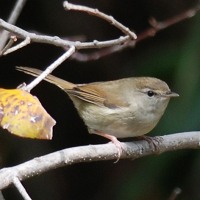 |
Japanese Bush Warbler (Cettia diphone)
UGUISU
Habitat: Woodlands, dry riverbeds, parks, residential areas and reed beds from lowlands to mountainous areas throughout Japan. Occurs especially in dense dwarf bamboo woods from spring to summer. Resident.
Voice: Song is well-known pheeuwhow ke kyo or continuously pipipi kekyo kekyo keyo (hoh hokekyo). Call is tchak, chek or chatt, similar to Wren, but Wren calls in lower and huskier voice.
See more
♪ song: M Ueta
♪ call: K Kajimoto
♪ fight: T Hirano
♪ subsong: K Kajimoto
|
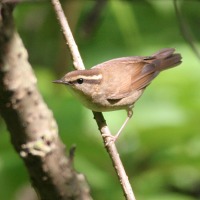 |
Asian Stubtail / Short-tailed Bush Warbler
(Urosphena squameiceps)
YABUSAME
Habitat: Woodlands from lowlands to mountainous areas throughout Japan. Summer visitor. Has a preference for slightly dark woods and woods on the slope.
Voice: Sings see see see see see or shiriririri loudly like an insect. Call is chichi or jiririri. Sometimes calls at night. There are no other birds with similar voice.
See more
♪ song: M Ueta ♪ song: K Mikami
♪ call: K Kajimoto ♪ call: K Kajimoto
♪ call: K Kajimoto ♪ fledgling: H Kuroda
|
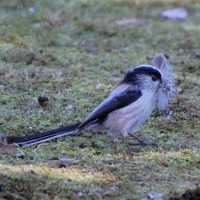 |
Long-tailed Tit (Aegithalos caudatus)
ENAGA
Habitat: Woodlands, deciduous woods, parks, open woods, dry riverbeds and residential areas from lowlands to mountainous areas throughout Japan. Resident. Calling each other constantly. A flock moves busily from one tree to another.
Voice: Similar to Great Tit/ Japanese Tit and Coal Tit, but can be identified as the voice of this species contains sree sree sree (juree juree juree).
♪ call: M Ueta ♪ call: K Kajimoto
♪ call: K Kajimoto ♪ call: K Kajimoto
♪ juvenile: K Kajimoto
|
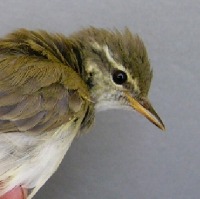 |
Kamchatka Leaf Warbler (Phylloscopus examinandus)
OOMUSHIKUI
[an error occurred while processing this directive]
♪ song: K Kajimoto
♪ song: K Kajimoto
|
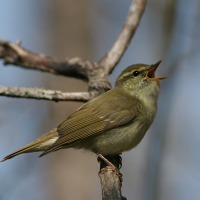 |
Japanese Leaf Warbler / Arctic Warbler (Phylloscopus xanthodryas)
MEBOSOMUSHIKUI
Habitat: Mainly woodlands in mountainous areas in Honshu and Shikoku. Summer visitor, but commonly appears in deciduous woods and parks in lowlands during migration seasons in spring and autumn.
Voice: Song is ziririri or drree ree ree ree (zenitori-zenitori which means money robber) slowly and repetitively. Call is dzit, dzik or bijt in husky voice. Kamchatka Leaf Warbler Phylloscopus borealis examinandus , which calls ji ji ro ji ji ro, stops over in deciduous woods and parks in lowlands around June during migration seasons.
See more
♪ song: T Hirano ♪ song: K Mikami
♪ call: K Kajimoto
|
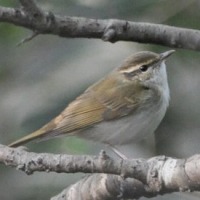 |
Pale-legged Leaf-warbler / Sakhalin Leaf Warbler
(Phylloscopus borealoides)
EZOMUSHIKUI
Habitat: Woodlands in mountainous areas in Honshu and northwards as a summer visitor, but in spring and autumn migration seasons commonly seen in lowland deciduous woods and urban parks.
Voice: Song is repeat tones, hee tsu key hee tsu key. Calls shortly, hit-hit.
♪ song: M Ueta
♪ call: M Ueta
|
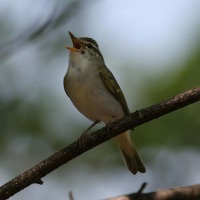 |
Eastern Crowned Warbler (Phylloscopus coronatus)
SENDAIMUSHIKUI
Habitat: Woodlands from hills and mountainous areas throughout Japan. Deciduous woods near residential areas and in parks during migration seasons in spring and autumn. Summer visitor.
Voice: Song is chiiyo chiiyo chiiyo biii or pichew pichew bwee (or shochu ippai guee, which means drink a glass of shochu in one gulp).Calls chi or chiu or phit phit in thin voice .
♪ song: M Ueta
♪ call: K Kajimoto
|
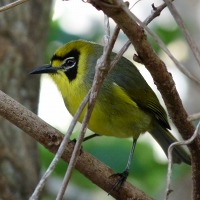 |
Bonin White-eye (Apalopteron familiare)
MEGURO
Habitat: Forests on Haha-jima island, Mukou-jima island and Hira-jima island in Ogasawara-shoto islands all year long. Foods are insects, spiders as well as fruits such as papaya and banana.
Voice: Calls tit tit or phi hoii in shriek voice.
See more
♪ call: M Ueta
♪ call: M Ueta
|
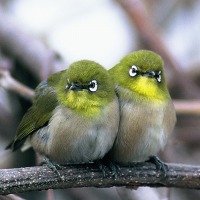 |
Japanese White-eye (Zosterops japonicus)
MEJIRO
Habitat: Woodlands , deciduous woods, parks and residential areas from lowlands to mountainous areas throughout Japan. Resident. Feeds on insects, fruits and nuts as well as nectar of the cherry and camellia.
Voice: Sings repeatedly in complicated note from around April. Calls tsee tsee, chi chi chi and kyuru kyuru kyru in various notes.
♪ song: M Ueta
♪ call: T Hirano ♪ call: K Kajimoto
♪ subsong: K Kajimoto
|
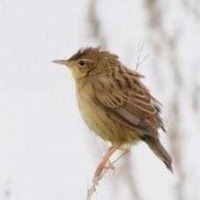 |
Lanceolated Warbler (Locustella lanceolata)
MAKINOSENNYUU
Habitat: Dry riverbeds and grasslands in lowlands in Hokkaido. Summer visitor of small number. Shows up in Honshu and to the south during migration, mainly in reed beds, but hard to find.
Voice: Song is chiri chiri jiririri in grassy areas like insects.
♪ song: T Nanba
♪ song: K Kajimoto
|
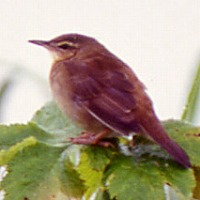 |
Middendorff's Grasshopper Warbler (Locustella ochotensis)
SHIMASENNYUU
Habitat: Dry riverbeds and grasslands in lowlands in Hokkaido. During migration, occurs mainly in reed beds in Honshu and to the south, but hard to find. Summer visitor.
Voice: Sings chitchi or pyuru pyuru pyuru on top of plants repeatedly. No other species sings similarly.
♪ song: K Kajimoto
|
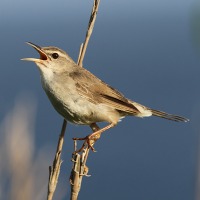 |
Styan's Grasshopper Warbler (Locustella pleskei)
UCHIYAMASENNYUU
Habitat: Breeds on islands and islets around Japan and Korean Peninsula. Mainly occurs in shrubs and grasslands on islets. Summer visitor. Body is subdued dark brown.
See more
♪ song: H Kuroda
♪ call: H Kuroda ♪ call: H Kuroda
♪ fledgling: H Kuroda
|
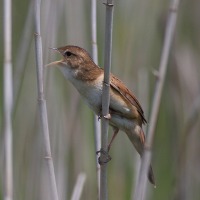 |
Marsh Grassbird (Locustella pryeri)
OOSEKKA
Habitat: Reed beds in lowlands in Honshu, but extremely localized.
Voice: Song is churuchuruchuruchuru or jukukuku kyurururu(jobi jobi jobi) in breeding season. Repeats the action of flying out of and returning to the grassy area singing. Call is chak chak chak or chur chur chur chur (ja ja) like Japanese Bush Warbler and moves around the ground surface in reed beds in autumn and winter. More muffled call than that of Japanese Bush Warbler.
See more
♪ song: T Hirano
♪ call: T Hirano ♪ alarm: T Hirano
♪ threat: T Hirano
|
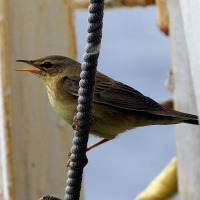 |
Gray's Grasshopper Warbler (Locustella fasciolata)
EZOSENNYUU
Habitat: Bushy grasslands in plains in Hokkaido as a summer visitor. In migration seasons occurs also in thickets and grasslands in woodland edges of Honshu and southwards, but difficult to see because it rarely sings.
Voice: Songs sounds like toppin kaketaka in loud shrill voice even at night during breeding season,
♪ song: M Ueta
♪ song: R Kurosawa
|
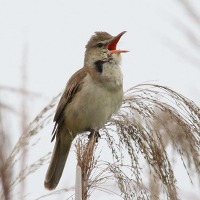 |
Oriental Reed Warbler (Acrocephalus orientalis)
OOYOSHIKIRI
Habitat: Reed beds around lakes and rivers as well as grasslands of Japanese silver grass from lowlands to mountainous areas throughout Japan. Summer visitor. Also occurs at regulation ponds in residential areas as long as reed beds exist there. Comes over to Japan around the end of April.
Voice: Sings loudly all day long. Song is louder and clearer than Black-browed Reed-warbler. Call is tack tick or treck krak kirr (jijit or juju).
♪ song: T Hirano
♪ call: T Hirano
|
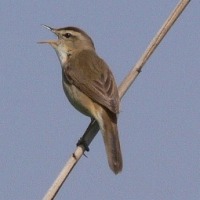 |
Black-browed Reed Warbler (Acrocephalus bistrigiceps)
KOYOSHIKIRI
Habitat: Reed beds and grasslands from lowlands to mountainous areas in Honshu and to the north. Summer visitor, arriving in Japan around May and staying until late October.
Voice: Resembles Great Reed-warbler, but higher and weaker. All day perching often on reed stems. Calls jee jee thickly.
♪ song: T Hirano
♪ call: T Hirano
|
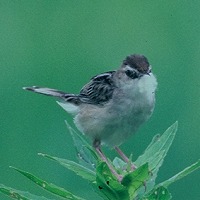 |
Zitting Cisticola (Cisticola juncidis)
SEKKA
Habitat: Grasslands, agricultural lands and dry riverbeds from lowlands to mountainous areas throughout Japan. Resident.
Voice: Zit zit zit or chin chin chin or dzip dzip dzip (hit hit hit jaja jaja jaja ) in flight and/or on grasses from spring to summer. In autumn-winter season, hit hit or hitchat in grassy areas.
♪ song: T Hirano
♪ call: H Kuroda ♪ call: T Hirano
|
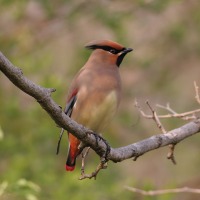 |
Japanese Waxwing (Bombycilla japonica)
HIRENJAKU
Habitat: Woodlands, parks and open woods in dry riverbeds with scattered trees from lowlands to mountainous areas throughout Japan. Winter visitor. Population varies year to year. In early spring before leaving Japan, can be observed in scrub woods near human settlements and dry riverbeds in lowlands.
Voice: Iii hiii chiri chiri chiri in weak voice. Call resembles Bohemian Waxwing, but Japanese Waxwing's includes hiii hiii call.
♪ call: T Hirano
♪ call: H Kuroda
|
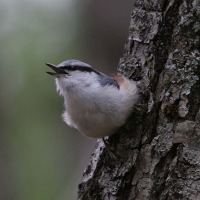 |
Wood Nuthatch / Eurasian Nuthatch (Sitta europaea)
GOJUUKARA
Habitat: Woodlands from lowlands to mountainous areas throughout Japan year round. In autumn and winter occurs also in deciduous woods in lowlands. Moves around on trunks and branches vertically.
Voice: Sings loudly fi fi fi continuously. Calls ju ju ju ju ju, also feeble chi f chi chi.
♪ song: T Hirano
♪ call: T Hirano ♪ call: T Hirano
|
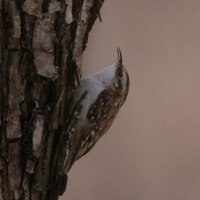 |
Eurasian Treecreeper / Common Treecreeper (Certhia familiaris)
KIBASHIRI
Habitat: Woodlands in mountainous areas throughout Japan through the year.
Voice: Sings loudly in inflective voice pichi pii pii chi chi chiririri from March. Calls tsee tsee or (shirii shirii) in thin voice. During breeding season, the voice sounds like the call of Asian Brown Flycatcher but can be distinguished by Treecreeper's lower sound.
♪ song: M Ueta ♪ song: T Hirano
♪ call: T Hirano ♪ call: M Ueta
|
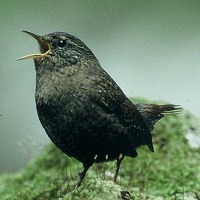 |
Eurasian Wren / Winter Wren (Troglodytes troglodytes)
MISOSAZAI
Habitat: Woodlands along streams, gloomy woods and reed beds from lowlands to mountainous areas throughout Japan. In winter in dark woods like Japanese cedar woods and near the ground in reed beds in lowlands.
Voice: Sings in complicated loud voice starting in March. Calls tet tet tet or chet chet chet (ji ji ji ji or ja ja ji ji) similar to Japanese Bush-warbler, but huskier.
♪ song: M Ueta
♪ call: T Hirano
♪ alarm: K Kajimoto
|
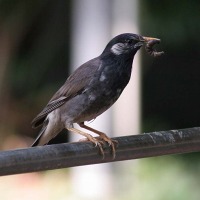 |
White-cheeked Starling (Spodiopsar cineraceus)
MUKUDORI
Habitat: Residential areas, agricultural lands, dry riverbeds and grasslands from lowlands to mountainous areas throughout Japan. Resident. Those in snow-covered areas move to warmer regions in winter.
Voice: Chestnut-cheeked Starling occurs in edge of woodlands in Honshu and to the north in breeding season whose song can be distinguished as it gives more complicated and metallic song than this species.
See more
♪ call: M Ueta
|
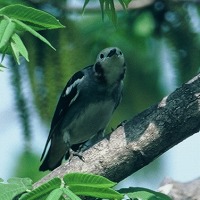 |
Chestnut-cheeked Starling (Agropsar philippensis)
KOMUKUDORI
Habitat: Woodlands and open woods from lowlands to mountainous areas in central Honshu and to the north. Summer visitor. Visits open woods in dry riverbeds in lowlands throughout Japan in migration season and sometimes, especially in autumn, roosts on roadside trees in urban district.
Voice: Distinguished by its more complicated and metallic voice than White-cheeked Starling. Call is similar to White-cheeked Starling.
See more
♪ call: T Hirano
|
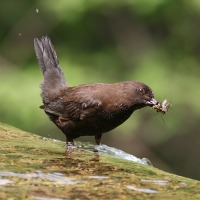 |
Brown Dipper (Cinclus pallasii)
KAWAGARASU
Habitat: Upper reaches of rivers and lakes from low mountains to mountainous areas throughout Japan year round.
Voice: Dzzeet cheet or zzit zzit (jet jet) while flying low over a stream. Sings in complicated chityiijoijoi (jiji joy joy ju ju ju) staying on rocks. Starts singing in February.
♪ song: T Hirano
♪ call: T Hirano
|
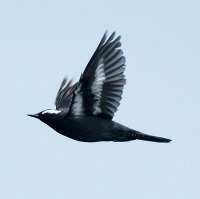 |
Siberian Thrush (Zoothera sibirica)
MAMIJIRO
Habitat: Woodlands in mountains in Honshu and Hokkaido. Summer visitor, but not in large numbers.
Voice: Sings in two notes, chobo chee and kyoro chee, which makes this species identifiable from Brown Thrush and Gray Thrush. Usually sings early in the morning. Call is kyo kyo or see.
♪ song: T Hirano
|
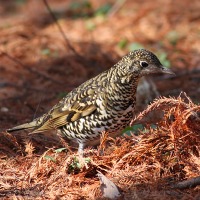 |
Scaly Thrush (Zoothera dauma)
TORATSUGUMI
Habitat: Woodlands, deciduous woods, and parks from lowlands to mountainous areas throughout Japan. Resident. In autumn and winter, occurs in deciduous woods near houses and shrubberies in parks.
Voice: Usually at night sadly, hee hee. Also sometimes sings even after dawn. Call is thin shee.
♪ song: M Ueta
♪ song: M Ueta
|
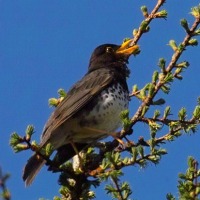 |
Japanese Thrush (Turdus cardis)
KUROTSUGUMI
Habitat: Woodlands from lowlands to mountainous areas throughout Japan. A summer visitor. Shows up even in parks in residential areas during migration.
Voice: Sings in complicated way like kyoron kyoron or kikiko kikiko. Sings similarly to Chinese Hwamei in hill woods but more inflective and occasionally in a high-pitched tone. Calls gyo gyo gyo see, with which it is identifiable from Laughingthrushes and large Thrushes
See more
♪ song: M Ueta
♪ song: T Hirano
♪ call: K Kajimoto
|
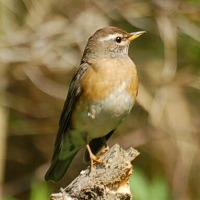 |
Eyebrowed Thrush (Turdus obscurus)
MAMICHAJINAI
Habitat: Woodlands, deciduous woods and shrubberies in parks from lowlands to mountainous areas throughout Japan. Passage migrant.
Voice: Siree or tsuee in flight, very similar to Pale Thrush and Brown Thrush. In early spring, sings like Brown Thrush, too.
♪ call: T Hirano
♪ call: K Kajimoto
♪ song: K Kajimoto
♪ song: K Kajimoto
|
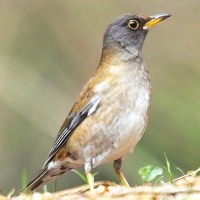 |
Pale Thrush (Turdus pallidus)
SHIROHARA
Habitat: Woodlands, shrubs, parks and dry riverbeds from lowlands to mountainous areas throughout Japan. Prefers darker woods and thickets. Winter visitor.
Voice: Call is ja,ja,ja or kyo, kyo, kyo or gyurururu roo. Shiree in flight, too. Hard to distinguish its call from Brown-headed Thrush only with their calls. Song is similar to Brown-headed Thrush in early spring.
♪ call: T Hirano
♪ call: K Kajimoto
♪ call: K Kajimoto
♪ song: T Hirano
|
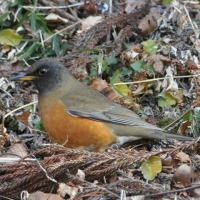 |
Brown Thrush / Brown-headed Thrush (Turdus chrysolaus)
AKAHARA
Habitat: Woodlands, deciduous woods, bamboo grasses on dry riverbeds, parks from lowlands to mountainous areas. Lives in mountainous open woods in summer.
Voice: Song is kyoron kyoron, or kyoron kyoron tswee. Similar to Siberian Ground Thrush / Siberian Thrush but can be recognized by the second clear sound. In early spring, very similar to Pale Thrush. Call is kyo, kyo kyo or tswee. Difficult to distinguish from Pale Thrush.
♪ song: T Hirano ♪ song: M Ueta
♪ call: T Hirano ♪ call: T Hirano
♪ call: T Hirano
|
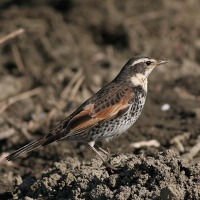 |
Naumann's Thrush (Turdus naumanni)
TSUGUMI
Habitat: Widely spread in woodlands, uncultivated fields, dry riverbeds, parks, agricultural lands, residential areas from lowlands to mountainous areas throughout Japan. Common winter visitor.
Voice: Call is kwa kwa or tsree. Prefers open space than Brown-headed Thrush or Pale Thrush. Stays until early May in central Honshu. Just before leaving, sings like Japanese Thrush. But can be distinguished by its low and indistinct voice.
♪ call: T Hirano
♪ subsong: T Hirano
|
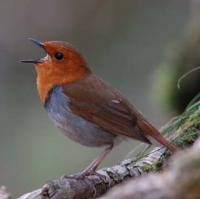 |
Japanese Robin (Luscinia akahige)
KOMADORI
Habitat: Woodlands in mountainous areas throughout Japan. Summer visitor. Often seen on or near the ground.
Voice: Song is strong and distinctive peen karakarakara (hin kara kara kara). Can be distinguished from Siberian Blue Robin, as Siberian Blue Robin gives introduction call of zit zit zit or chitt chitt chitt (hit hit hit) and its song can be heard hichohichohicho (chori chori chori)as well. Call is tun tun or hii and tsip (hi chi chi chi chi).
♪ song: T Hirano
♪ call: K Kajimoto
|
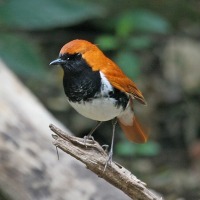 |
Ryukyu Robin (Erithacus komadori / Luscinia komadori)
AKAHIGE
Habitat: Woodlands in mountains of Danjogunto islands, Tokararetto islands, Amami-ohshima island and Okinawa-honto (main island) year round.
Voice: Song is hin-ryui chori chori chori similar to Siberian Blue Robin which lives in the middle of Honshu extending northward, but can be distinguished from Siberian Blue Robin whose song is preceded by a series of chit chit chit notes. Call is goock goock or hee hee.
See more
♪ song: S Seki ♪ song: T Moriya
♪ subsong: K Ishida
|
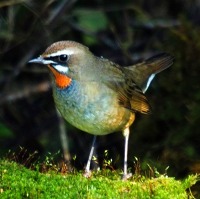 |
Siberian Rubythroat (Luscinia calliope)
NOGOMA
Habitat: Wild areas, scrub forests and agricultural lands from lowlands to mountainous areas in Hokkaido. Summer visitor. Observed in scrub forests, reed beds and dwarf bamboo groves near residential areas in Honshu and to the south in migration seasons.
Voice: Sings repeatedly kyoro kiri hyogori kii kyorochirit (pee chorichi) in refreshingly cool tone. Calls vehp or jutt (gu gu gu) in muffled voice. Stonechat, which occurs in similar habitats, gives a longer song with especially longer latter part.
♪ song: K Kajimoto
♪ call: T Hirano
|
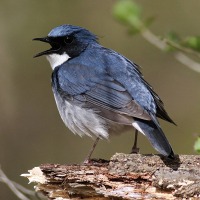 |
Siberian Blue Robin (Luscinia cyane)
KORURI
Habitat: Woodlands in mountainous areas throughout Japan. Summer visitor. Often occurs in dense scrub such as dwarf bamboo bush.
Voice: Similar to Japanese Robin, but can be distinguished by its long introduction zii zii zii or chii chii chii (hit hit hit) before the inflective and strong song. Even when it does not give the prelude, can be distinguished by its weaker song hichohichohicho (chori chori chori) from Japanese Robin.
♪ song: M Ueta
|
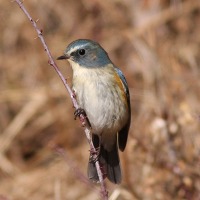 |
Red-flanked Bluetail (Tarsiger cyanurus)
RURIBITAKI
Habitat: Common in mountain forests throughout Japan from spring to summer and in woodlands, and parks from lowlands to low mountains in autumn and winter.
Voice: Sings hichuri churiririchurochii or hyoro hyurururip (peeroro peeruro) loudly and repetitively in summer, but song slightly different by areas where it occurs. Gives the song in woods in lowlands in autumn. Calls tuc tuc tuc or heet kait kait (hit hit or kakat or ku ku ku) in muffled tone. Call very similar to Daurian Redstart and difficult to identify. Daurian Redstart prefers open woods and agricultural lands which are different habitats from that of Red-flanked Bluetail.
♪ song: T Hirano ♪ song: K Mikami
♪ song: M Ueta
♪ call: K Kajimoto ♪ call: K Kajimoto
♪ odd vocalization: K Kajimoto
|
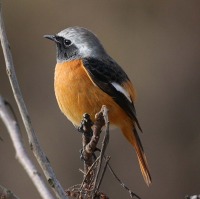 |
Daurian Redstart (Phoenicurus auroreus)
JOUBITAKI
Habitat: Open woods, agricultural lands, parks, residential areas and on dry riverbeds from lowlands to mountainous areas throughout Japan. Common winter visitor. Some move in midwinter from north with a lot of snowfall to warmer regions.
Voice: Before leaving Japan in spring, and also in autumn, sings elaborately. On arrival in Japan in autumn, repeats call hit hit, ka ka ka on antennas, power lines and tree branches. Closely resembles the call of Red-flanked Bushrobin/Red-flanked Bluetail and hard to distinguish the two species from each other by the voice. Red-flanked Bushrobin/Red-flanked Bluetail tends to stay inner in woods.
♪ call: H Kuroda ♪ call: T Hirano
♪ subsong: T Hirano ♪ subsong: S Murahama
|
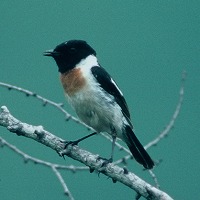 |
African Stonechat (Saxicola torquatus)
NOBITAKI
Habitat: Grasslands, wetlands, agricultural lands and dry riverbeds from lowlands to mountainous areas throughout Japan. Summer visitor or passage migrant. Breeds in central Honshu and to the north. Commonly observed in lowlands in spring and autumn migration seasons. Catches food by flying down from tip of a branch or top of a pole to the ground and returns.
Voice: Call is ja ja, jat or hit and sings in complicated refreshingly cool voice.
♪ song: K Kajimoto
♪ call: K Kajimoto
♪ threat: T Hirano
|
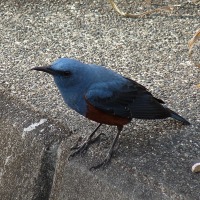 |
Blue Rock Thrush (Monticola solitarius)
ISOHIYODORI
Habitat: Reefs near seashores and neighboring residential areas throughout Japan all year round, but in autumn and winter, seen in inland building areas and rocky hills.
Voice: Song is complicated heechoicho peechiyo hiyochee pee pipipi or tju sri tjurr titi wuchi trr trrt tri (hee churi chee churu riru). Call is hee or chin. Female looks like Brown-eared Bulbul but the tail of this species is not long as Bulbul.
♪ song: K Kajimoto
♪ call: M Ueta
|
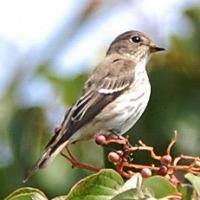 |
Grey-streaked Flycatcher (Muscicapa griseisticta)
EZOBITAKI
Habitat: Mainly in autumn in woodlands, open woods in dry riverbeds and in parks from lowlands to mountainous areas throughout Japan.
Voice: Call is thin tsuii or chii (see or tse). Similar to Asian Brown Flycatcher and Dark-sided Flycatcher. Can be identified from the other two species by distinctive grey-black streaks from throat to breast.
♪ call: T Hirano ♪ call: K Kajimoto
♪ call: K Kajimoto
|
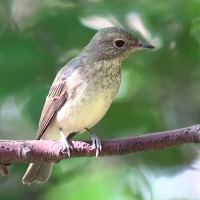 |
Dark-sided Flycatcher (Muscicapa sibirica)
SAMEBITAKI
Habitat: Woodlands in mountainous areas in Honshu and to the north. Summer visitor.
Voice: Sings complicated note in high voice. Call is a thin tsuii or chii (see or tse).
The appearance and voice are so similar to Asian Brown Flycatcher which occurs in low mountainous areas that it’s difficult to distinguish from each other. Dark-sided Flycatcher inhabits woodlands in higher altitude mountains.
♪ call: H Kuroda
|
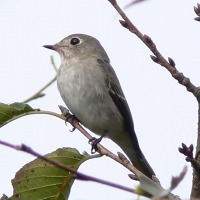 |
Asian Brown Flycatcher (Muscicapa dauurica)
KOSAMEBITAKI
Habitat: Open woodlands from lowlands to mountainous areas throughout Japan. Summer visitor. Visits parks in residential areas and deciduous woods during migration seasons in spring and autumn.
Voice: Sings in high note with complicated melody which includes copies from a part of Narcissus Flycatcher’s song. Calls tsuii or chee (see or tseh) in thin voice. Both appearance and voice are similar to those of Dark-sided Flycatcher, which occurs in forests in higher altitude.
♪ song: T Hirano ♪ song: K Kajimoto
♪ call: K Kajimoto ♪ call: T Hirano
♪ mimic: T Hirano
♪ alarm: T Hirano
|
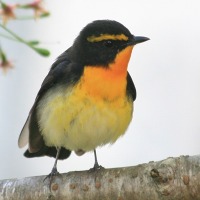 |
Narcissus Flycatcher (Ficedula narcissina)
KIBITAKI
Habitat: Woodlands throughout Japan mostly as summer bird. In spring and autumn, observed even in residential areas.
Voice: Song is distinctive and repeated note pi pe poi (or, pi piriri, pi piriri) following pi ri voice, but must be careful as the repeated part is sometimes missing. Similar to Blue-and-white Flycatcher, but it sings more freely and restfully than Narcissus Flycatcher and includes jitt jitt or hii rii rii chin jiriri note in the middle of a song.
♪ song: M Ueta ♪ call: T Hirano
♪ fight: K Kajimoto ♪ fledgling: K Kajimoto
♪ odd vocalization: K Kajimoto
♪ odd vocalization: K Kajimoto
|
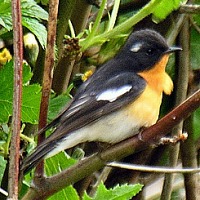 |
Mugimaki Flycatcher (Ficedula mugimaki)
MUGIMAKI
[an error occurred while processing this directive]
♪ song: K Kajimoto
♪ song: K Kajimoto
|
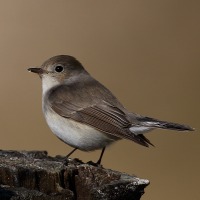 |
Taiga Flycatcher (Ficedula albicilla)
OJIROBITAKI
♪ call: T Hirano
|
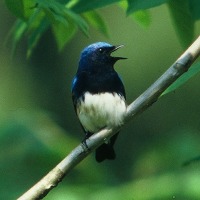 |
Blue-and-white Flycatcher (Cyanoptila cyanomelana)
OORURI
Habitat: Woodlands throughout Japan. Often in woods along mountain streams. Mainly summer visitor. In spring and autumn can be observed even in residential areas.
Voice: Sings freely with a restful voice, and typically includes ji ji or jii ri ri notes in the middle of the song. Song of Narcissus Flycatcher resembles, but it sings more restlessly, and typically includes the repeated note pi piriri, pi piriri, etc., in the middle of the song.
♪ song: M Ueta
♪ call: K Kajimoto
♪ female song: K Kajimoto
|
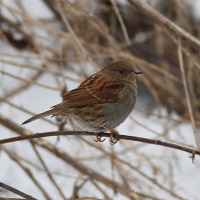 |
Japanese Accentor (Prunella rubida)
KAYAKUGURI
Habitat: High mountains in Honshu and Shikoku at breeding season. Occurs at the edge of bushes and dwarf bamboo bushes from lowlands to mountainous areas during autumn and winter.
Voice: Sings repeated tsee tsee syuu tsee tsee syuu, chiri chirichiri or chuririri chuuchii hirihirichiririri (hee chori chori chori) in high note. Tsuririri or chiririri in thin and high voice in autumn and winter.
♪ call: K Kajimoto
|
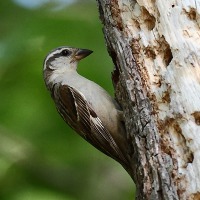 |
Russet Sparrow (Passer rutilans)
NYUUNAISUZUME
Habitat: Open woods, wild areas, agricultural lands and dry riverbeds from lowlands to mountainous areas throughout Japan. Resident. Breeding in Honshu is limited to mountains in central Honshu and to the north. Seen in flocks in agricultural lands in lowlands in central Honshu and to the south in autumn and winter.
Voice: Call is greatly similar to Tree Sparrow/Eurasian Tree Sparrow but can be distinguished because Russet includes much of chee tsuri pyo piriri (hee hee hee) note.
♪ call: T Hirano
♪ call: T Hirano
|
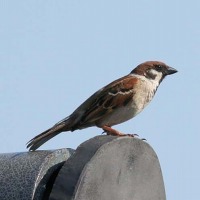 |
Eurasian Tree Sparrow / Tree Sparrow (Passer montanus)
SUZUME
Habitat: Around houses, in agricultural lands, and dry riverbeds from lowlands to mountainous areas throughout Japan. Resident.
Voice: Russet Sparrow breeds in mountainous areas in Hokkaido and northern Honshu, but can be distinguished as Russet’s call includes more chee tsuri pyo piriri (he he) voice. Difficult to distinguish by voice in autumn and winter, when both species live in agricultural lands, and grassy areas of dry riverbeds.
♪ call: M Ueta ♪ call: M Ueta
♪ call: T Hirano
|
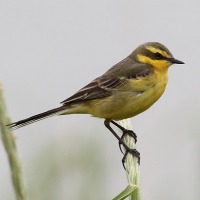 |
Western Yellow Wagtail (Motacilla flava)
TSUMENAGASEKIREI
Habitat: Mainly rivers, tidal flats, marshes and watersides of agricultural lands in lowlands throughout Japan. Rare winter visitor or passage migrant. A few breeds in northern Hokkaido.
Voice: Looks like Grey Wagtail but can be distinguished by its unclear call.
♪ call: K Kajimoto
|
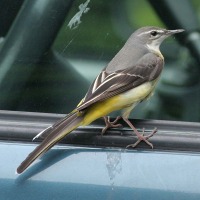 |
Grey Wagtail (Motacilla cinerea)
KISEKIREI
Habitat: Urban areas, rivers, lakes and agricultural lands from lowlands to mountainous areas throughout Japan. Resident.
Voice: Song is tzii tz tzi tzee ree ree ree (kishi kishi kishi,choi choi choi )starting in March on power lines and roof tops. The voice is clearer and higher than Japanese Wagtail. Calls chichin chichin in flight like the call of White Wagtail but higher.
♪ song: M Ueta
♪ call: T Hirano
|
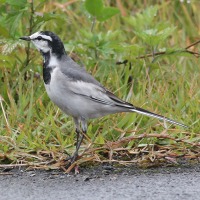 |
White Wagtail (Motacilla alba)
HAKUSEKIREI
Habitat: Coasts, rivers, lakes and marshes, urban areas, and agricultural lands from lowlands to mountainous areas throughout Japan all year round. Abundant resident.
Voice: Starting in March, complicated songs on the ground, and chihoo or chibee separately at noticeable place such as on power lines and outside TV antennas. The complicated song is similar to Japanese Wagtail but Japanese Wagtail sings louder and clearer. Call resembles Grey Wagtail but a little lower.
♪ subsong: T Hirano
♪ call: T Hirano ♪ call: T Hirano
|
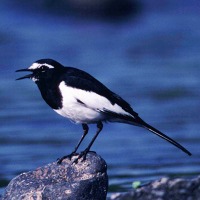 |
Japanese Wagtail (Motacilla grandis)
SEGUROSEKIREI
Habitat: Rivers, lakes, urban areas and agricultural lands from lowlands to mountainous areas throughout Japan. Resident.
Voice: Repeats with loud and clear voice at highly noticeable places from around the end of February. Similar to White Wagtail, but has clearer melody. Call is sharp pyitsui pyitui and when moving jiji jiji. Huskier than White Wagtail and Grey Wagtail.
See more
♪ call: T Hirano
♪ call: T Hirano
♪ alarm: T Hirano
|
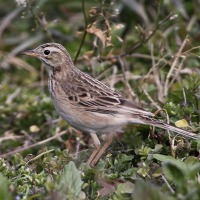 |
Richard's Pipit (Anthus richardi)
MAMIJIROTAHIBARI
♪ call: T Moriya
|
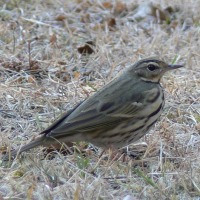 |
Olive-backed Pipit (Anthus hodgsoni)
BINZUI
Habitat: Forests, parks and other places from lowland to mountainous areas throughout Japan. Inhabits forests and open woods in mountainous areas during summer and moves to woods and open woods in parks in lowlands in autumn and winter.
Voice: Song is a complex tune like Skylark/ Eurasian Skylark from spring to summer. Song ends with been zizizi (been zuizui).Call is dzzi dsst tsez zii or duii (jin,or bin tswee) while foraging on the ground or flying, which can be distinguished from similar looking American Pipit/ Buff-bellied Pipit or Skylark/ Eurasian Skylark.
♪ song: M Ueta
♪ call: K Kajimoto
|
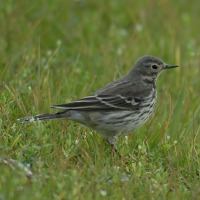 |
Buff-bellied Pipit (Anthus rubescens)
TAHIBARI
Habitat: Open areas such as rivers, lakes and agricultural lands in lowlands throughout Japan. Winter visitor.
Voice: Sings occasionally in complicated notes on its arrival in autumn. Calls sharply pit pi pi or tseep when it flies off or in flight. Can distinguish from similar looking Olive-backed Pipit and Eurasian Skylark by its sharp call.
♪ call: M Ueta
♪ call: K Kajimoto |
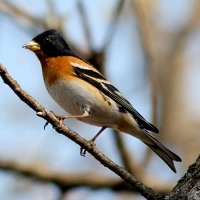 |
Brambling (Fringilla montifringilla)
ATORI
Habitat: Woodlands, deciduous woods, agricultural lands and parks from lowlands to mountainous areas throughout Japan. Winter visitor. Moves in flocks of several to hundreds of birds.
Voice: Similar to but stronger than Common Crossbill, seen in woods. Gyueen is similar to but stronger and louder than Grey-capped/ Oriental Greenfinch and Siskin/Eurasian Siskin. Grey-capped/ Oriental Greenfinch is mixed with kiri kiri kiri and other sounds.
♪ call: M Ueta
♪ call: K Kajimoto
♪ subsong: T Hirano
|
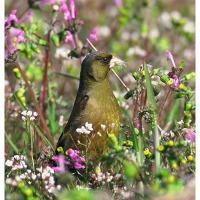 |
Oriental Greenfinch / Grey-capped Greenfinch (Chloris sinica)
KAWARAHIWA
Habitat: Woodlands, deciduous woods, agricultural lands, dry riverbeds, parks and residential areas from lowlands to mountainous areas throughout Japan through the year.
Voice: Sings in vigorous kirikiri korokoro been on power lines and antennas in residential areas from spring to summer. Been is similar to Brambling but can be distinguished as this species includes korokorokoro voice. Call is similar to Japanese White eye’s call, krikirikiri , but can be distinguished as it calls continuously and gives the call chi or tsee.
♪ song: R Kurosawa ♪ song: T Hirano
♪ call: M Ueta ♪ call: M Ueta
♪ juvenilebegging: R Kurosawa
♪ odd vocalization: K Kajimoto
|
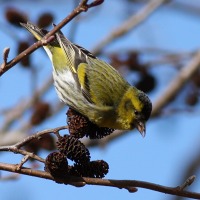 |
Eurasian Siskin / Siskin (Carduelis spinus)
MAHIWA
Habitat: Woodlands, deciduous woods, parks and on dry riverbeds from lowlands to mountainous areas throughout Japan. Winter visitor, but shows up in mountains in central Honshu and to the north even in summer.
Voice: Kchu kchu kchu rapidly and indistinctly, and sometimes chween, too.
♪ call: T Hirano
|
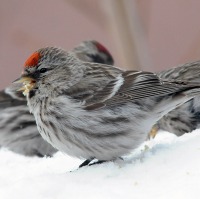 |
Common Redpoll (Carduelis flammea)
BENIHIWA
Habitat: Woodlands, open woods, uncultivated lands, and dry riverbeds from lowlands to mountainous areas in central Honshu and to the north. Winter visitor. The population varies by year.
Voice: Calls chu chu in flight, and chewee occasionally.
♪ call: M Ueta
|
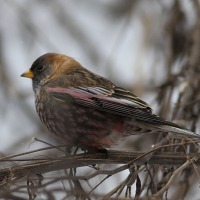 |
Asian Rosy Finch (Leucosticte arctoa)
HAGIMASHIKO
Habitat: Scree-covered slopes, rocky areas, agricultural lands and dry riverbeds, etc. from lowlands to mountainous areas throughout Japan. Winter visitor. Usually moves in flocks.
Voice: Calls fi tch fi tch, and fi fi fi continuously.
♪ call: M Ueta
|
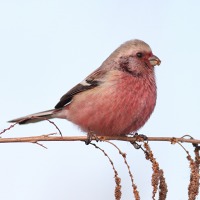 |
Long-tailed Rosefinch (Uragus sibiricus)
BENIMASHIKO
Habitat: Open woods, scrub forests, grasslands, dry riverbeds and agricultural lands from lowland to mountainous areas throughout Japan. Breeds in Hokkaido, and a winter visitor to Honshu and to the south.
Voice: Call is distinctive hwit hwot fee fee pee popo (pee poi pee poi fee,fee,fee), and song in breeding sites can be as complicated as churu churu chee fee fee fee (pee churu chuchee). Fee fee sounds like Bullfinch/ Eurasian Bullfinch in mountain forests but easily identified as this species includes characteristic call pee popi.
♪ call: T Hirano
♪ call: M Ueta
|
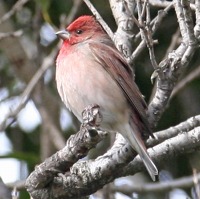 |
Common Rosefinch (Carpodacus erythrinus)
AKAMASHIKO
♪ call: A Hashida
|
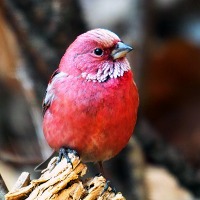 |
Pallas's Rosefinch (Carpodacus roseus)
OOMASHIKO
Habitat: Woodlands and scrub woods, mainly from lowlands to mountainous areas in Honshu and to the north.Winter visitor.
Voice: Calls chee chee like Hawfinch, but the voice is more metallic. Also calls strongly pii bii.
♪ call: H Kuroda
|
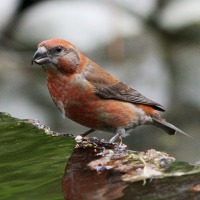 |
Red Crossbill (Loxia curvirostra)
ISUKA
Habitat: Forests and deciduous woods from lowlands to mountainous areas throughout Japan. Mainly winter visitor, but there are some breeding records.
Voice: Song is complicated melody. Call is repeated and hurried chup chup chup, jip jip jip or glipp glipp glipp (gyo gyo gyo). Similar to Brambling but can be identified by slightly huskier voice and Brambling's includes dzwee (gyuee).
♪ call: T Nanba ♪ call: T Nanba
♪ song: K Mikami ♪ subsong: T Nanba |
 |
Two-barred Crossbill (Loxia leucoptera)
NAKIISUKA
♪ subsong: T Nanba
|
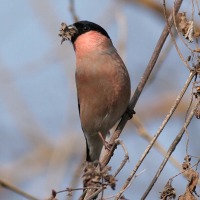 |
Eurasian Bullfinch / Bullfinch (Pyrrhula pyrrhula)
USO
Habitat: Woodlands and deciduous woods from lowlands to mountainous areas throughout Japan all year long, but lives in mountain woodlands in summer.
Voice: Call is teu teu teu or pheew pheew pheew (fee fee) like a whistle. Partly similar to Long-tailed Rosefinch, but can easily distinguish because Rosefinch includes rhythmic note pee popo (pee poi).
♪ call: M Ueta ♪ call: M Ueta
♪ song: R Kurosawa
♪ song: R Kurosawa
|
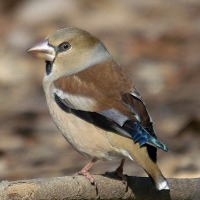 |
Hawfinch (Coccothraustes coccothraustes)
SHIME
Habitat: Woodlands, deciduous woods, agricultural lands, parks and residential areas from lowlands to mountainous areas throughout Japan. Common resident. While breeds in Hokkaido, it is mainly a winter visitor in Honshu and to the south.
Voice: Sings chee chee, tsee or bitch bitch. Chee resembles Japanese White-eye, but this species calls higher and thinner.
♪ call: K Kajimoto
|
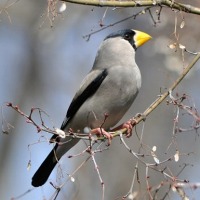 |
Japanese Grosbeak (Eophona personata)
IKARU
Habitat: Forests, deciduous woods and parks from lowlands to mountainous areas throughout Japan all year round.
Voice: Sings tsuki hi hoshi (kee kee koh kee). Call is tuk tuk (kyo kyo kyo or que que que).
♪ song: K Kajimoto
♪ call: K Kajimoto ♪ call: K Kajimoto
♪ call: K Kajimoto
♪ odd vocalization: H Kuroda
|
 |
Lapland Longspur (Calcarius lapponicus)
TSUMENAGAHOOJIRO
♪ call: T Nanba
|
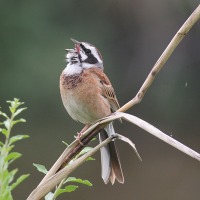 |
Meadow Bunting (Emberiza cioides)
HOOJIRO
[an error occurred while processing this directive]
♪ song: M Ueta
♪ call: M Ueta ♪ call: K Kajimoto
♪ fledgling: K Kajimoto
|
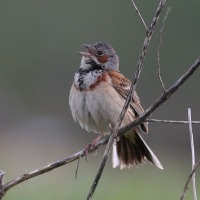 |
Chestnut-eared Bunting (Emberiza fucata)
HOOAKA
Habitat: Short grass areas, dry riverbeds, wetlands and agricultural lands from lowlands to mountainous areas throughout Japan. Resident. Those in northern Japan move to warmer regions in winter.
Voice: Song is similar to Meadow Bunting without inflection. Call is similar to Black- faced Bunting but difficult to identify.
♪ song: T Moriya ♪ song: T Hirano
♪ call: T Hirano
|
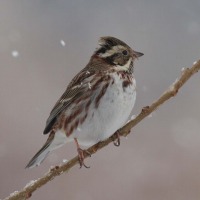 |
Rustic Bunting (Emberiza rustica)
KASHIRADAKA
Habitat: Bushes, open woods, agricultural lands and dry riverbeds from lowlands to mountainous areas throughout Japan. Winter visitor.
Voice: Calls tsip or fuchip (chi, chi) each sound separately. Call is similar to Black-faced Bunting, Yellow-browed Bunting and Meadow Bunting. This species does not call thickly like Black-faced Bunting while its call is more tenuous than Meadow Bunting. Difficult to distinguish from Yellow-browed Bunting by their calls. Song is similar to Skylark in early spring, but can be identified as its song is indistinct and lacks inflection compared with Skylark.
♪ call: T Hirano
♪ subsong: T Hirano
|
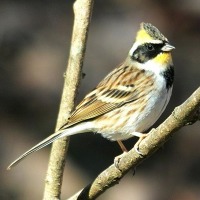 |
Yellow-throated Bunting (Emberiza elegans)
MIYAMAHOOJIRO
Habitat: Woodlands, agricultural lands and dry riverbeds from lowlands to mountainous areas in Honshu and to the south. Mainly as a winter visitor.
Voice: Calls tsi or tsi ti tsip in thin voice similar to the call of Rustic Bunting and Black-faced Bunting. Can be distinguished from the call of Black-faced Bunting as it is lower and thicker, but difficult to distinguish from Rustic Bunting by call. Sometimes sings even in winter in undertones.
♪ call: K Kajimoto
♪ song: K Kajimoto
|
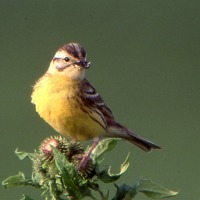 |
Yellow-breasted Bunting (Emberiza aureola)
SHIMAAOJI
Habitat: Small numbers in wetlands, dry riverbeds, grasslands and agricultural lands in lowlands in Hokkaido. Summer visitor.
Voice: Song is hiyo hiyo heeyoh hee. Similar to Siberian Rubythroat which prefers the similar habitat, but identifiable by the rhythmically repeated song.
♪ song: T Nanba
|
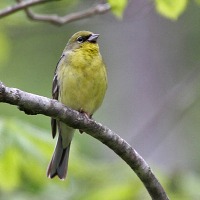 |
Yellow Bunting (Emberiza sulphurata)
NOJIKO
Habitat: Forests and open woods in dry riverbeds from lowlands to mountainous areas in Honshu. Summer visitor, but distribution is localized.
Voice: Song is similar to Black-faced Bunting, but can be distinguished because the first part of Black-faced Bunting is more of a drawl. Can be distinguished from Meadow Bunting as it gives rather uninflected song. Call is tsip tsip quite similar to Black-faced Bunting and hard to distinguish.
♪ song: T Hirano
♪ song: M Ueta
|
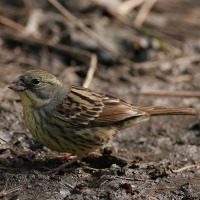 |
Black-faced Bunting (Emberiza spodocephala)
AOJI
Habitat: Open woods, shrubs, agricultural lands, dry riverbeds and parks from lowlands to mountainous areas throughout Japan year round. Breeds mostly in open woods and shrubs in mountains in Honshu and to the south.
Voice: Song is easy to distinguish from Yellow Bunting and Meadow Bunting, which live in similar environment, as drawling pit chon is inserted in the first half of the song. Call is a thick and low note.
♪ call: K Kajimoto
♪ song: T Hirano
|
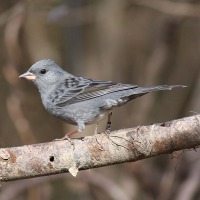 |
Grey Bunting (Emberiza variabilis)
KUROJI
Habitat: Woodlands throughoutJapan. Occurs in mountain woods in central Honshu and to the north in summer, and dense woods from lowlands to low mountains in central Honshu and to the south in autum and winter.
Voice: Sings hoy chee and other songs repeatedly while breeding. Calls chit or tsut in a note, clearer and higher than Black-faced Bunting and Rustic Bunting.
♪ song: M Ueta ♪ song: T Hirano
♪ call: T Hirano
♪ subsong: T Hirano
|
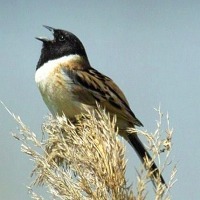 |
Japanese Reed Bunting (Emberiza yessoensis)
KOJURIN
Habitat: Grasslands, agricultural lands and dry riverbeds from lowlands to mountainous areas in Honshu and Kyushu all year long. Locally distributed in breeding season, while in areas of dry and short grass in dry riverbeds and agricultural lands in autumn and winter.
Voice: Song is similar to Black-faced Bunting and Meadow Bunting but the former half part of the song is not slow as Black-faced Bunting and less inflective than Meadow Bunting. Call is different from Rustic Bunting because it gives thick sound as bii bii in addition to common chi, chi.
♪ song: H Kuroda
♪ call: T Hirano
|
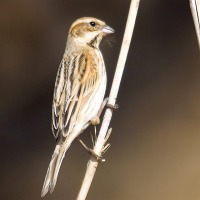 |
Common Reed Bunting (Emberiza schoeniclus)
OOJURIN
Habitat: Lakes and marshes, reed beds on dry riverbeds mainly in lowlands throughout Japan in autumn and winter. Wetlands or reed beds in northern Honshu and Hokkaido in summer.
Voice: Song is like Meadow Bunting, but distinguishable by a bit higher and thicker voice. Call is chi or chuuun. No other resembling call.
♪ call: T Hirano
♪ song: H Kuroda
|
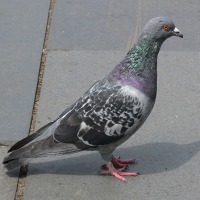 |
Rock Dove (Columba livia)
DOBATO
Habitat: Urban areas, rivers, agricultural lands and parks in lowlands. Common resident. Slightly larger than Oriental Turtle Dove with variety of colors such as gray-black, blue-gray and white. Alien species that became feral from domesticated birds.
Voice: Repeat of bru u oo u or oo oo oo (gruppo, gruppo).
♪ call: M Ueta
|
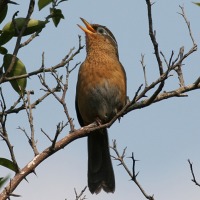 |
Chinese Hwamei (Garrulax canorus)
GABICHOU
Habitat: Woodlands with a lot of bamboo grasses , deciduous woods, dry riverbeds and parks from lowlands to mountainous areas in Honshu and the southwards year round. An alien species originally from southern China to northern Southeast Asia.
Voice: Sings repeatedly in a loud voice like Japanese Thrush, but can be distinguished because of the more monotonous and much longer song.
♪ song: M Ueta
♪ call: E Miyazawa |
 |
Crested Myna (Acridotheres cristatellus)
HAKKACHOU
♪ call: H Kuroda ♪ call: H Kuroda
♪ attack: H Kuroda ♪ attack: H Kuroda
|
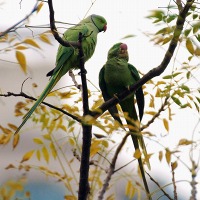 |
Rose-ringed Parakeet (Psittacula krameri)
HONSEIINKO
Habitat: Mainly urban areas in Honshu. An alien species native to India and Sri Lanka. Huge flocks live especially in Tokyo metropolitan area through the year. A green bird with a long tail in pigeon size.
Voice: kyik kyik kyik or keeew (pyii pyii).
♪ call: M Ueta
|
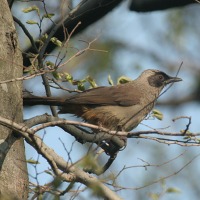 |
Masked Laughingthrush (Garrulax perspicillatus)
KAOGUROGABICHOU
Habitat: Lowland woodlands forests, deciduous woods and shrubs in agricultural lands locally in Kanagawa Prefecture and Tokyo Metropolis in Honshu year round. Similar to Brown-eared Bulbul in size and shape, but can be easily distinguished by the black eye rings and the reddish-brown plumage. Invasive alien species. Originally came from southeastern China and Hong Kong.
♪ call: E Miyazawa
|
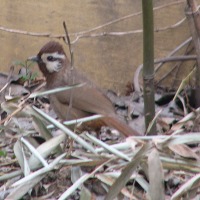 |
White-browed Laughingthrush (Garrulax sannio)
KAOJIROGABICHOU
Habitat: Shrubs and woods and in parks from lowlands to low mountains particularly across Gunma Prefecture in Honshu year round. Invasive alien species. Came from southeastern and east Asia.
Voice: Song is noisy gyo gyo gyo jui jui jee. Similar to Brown-eared Bulbul in size and shape, but can be easily distinguished by the whitish parts around the eyes and the reddish-brown mantle.
♪ song: T HIRANO ♪ call: T Hirano
|
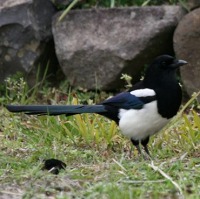 |
Eurasian Magpie / Black-billed Magpie (Pica pica)
KASASAGI
Habitat: Agricultural lands, residential areas and deciduous woods in lowlands in Kyushu, Honshu and Hokkaido year-round, but only small numbers seen limitedly except in northern Kyushu. Similar to Azure-winged Magpie in shape, but this bird is distinguishable by its slightly bigger size and black and white plumage.
Voice: Calls gyah gyah gyah hoarsely.
♪ call: R Kurosawa
|
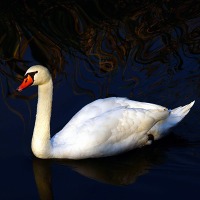 |
Mute Swan (Cygnus olor)
KOBUHAKUCHOU
♪ call: K Kajimoto
|
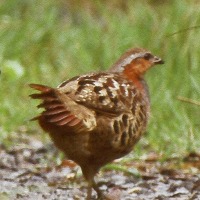 |
Chinese Bamboo Partridge (Bambusicola thoracicus)
KOJUKEI
Habitat: Shrubs or open woods from lowlands to mountainous areas in Honshu and to the south all year, where it seldom snows.
Voice: Sings Chotto koi chotto koi (chottokoi means come here a minute) repeatedly in a loud voice, or, sometimes peer or kyoor in a high-pitched voice. Resembles the voice of Japanese Woodpecker or Goshawk (or Northern Goshawk), but pauses longer between songs, often inserting other notes like koko koko ko.
♪ call: M Ueta ♪ call: T Hirano
♪ call: M Ueta
|
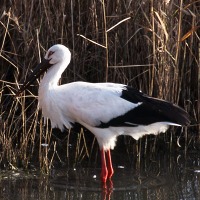 |
Oriental Stork (Ciconia boyciana)
KOUNOTORI
♪ cluttering: H Kuroda
|
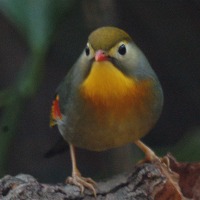 |
Red-billed Leiothrix (Leiothrix lutea)
SOUSHICHOU
Habitat: Woodlands, deciduous woods and parks with a lot of dwarf bamboos from lowlands to mountainous areas in Kanto and to the south. Resident. An introduced species originated from northern India to northern Vietnam and southern China.
Voice: Calls zye zye (gizee zee, gizee zee) like Bull-headed Shrike but more muffled than the shrike. Song is Repetitive as pichoi choi choi choi.
♪ song: K Kajimoto ♪ song: K Kajimoto
♪ call: M Ueta
|
|
|
|
|
|
|
|
|
|
|
|
|
|
|
|
|
|
|
|
|
|
|
|
|
|
|
|
|
|
|
|
|
|
|
|
|
|
|
|
|
|
|
|
|
|
|
|
|
|
|
|
|
|
|
|
|
|
|
|
|
|
|
|
|
|
|
|
|
|
|
|
|
|
|
|
|
|
|
|
|
|
|
|
|
|
|
|
|
|
|
|
|
|
|
|
|
|
|
|
|
|
|
|
|
|
|
|
|
|
|
|
|
|
|
|
|
|
|
|
|
|
|
|
|
|
|
|
|
|
|
|
|
|
|
|
|
|
|
|
|
|
|
|
|
|
|
|
|
|
|
|
|
|
|
|
|
|
|
|
|
|
|
|
|
|
|
|
|
|
|
|
|
|
|
|
|
|
|
|
|
|
|
|
|
|
|
|
|
|
|
|
|
|
|
|
|
|
|



















































































































































































































































